Introduction
In the Tourist Office of Darwin, I collected all the brochures available and sat down and started reading. It was not easy to choose the right tour to the Kakadu National Park. The tours on offer were just overwhelming.
I think I have decided for the right one: the AAT Kings' four days (three nights) tour for $695, even if it was a compilation of different tours of different companies.
That was not the cheapest, though. A little cheaper was another one for $640, but more cheap was what they had to offer: only for people under 40 years old not minding sleeping in a swag (outdoor sleeping bag) under the sky or in a tent. I would not have minded sleeping in a tent, but only if I would have had my own vehicle going on my own tour and stay were I want and how long.
On the way to Kakadu
On Sunday morning I was picked up at 6:20 a.m. from my Cave (the Cavenagh Backpacker and Motel). I carried only my overnight bag (for the three nights) and a small rucksack for the day. My suitcase I left in the storage room of the Cave.
We were around thirty people with a high age average. Our nice lady guide, Lynne, was telling us some facts about Darwin and Kakadu and a brief insight into history and culture while she was driving.
Also some stories, for example: fishermen from Indonesia get caught fishing in Australian waters, their boats destroyed (not much worth anyway) and the fishermen put to jail with 3 meals a day, etc. then eventually flown out back to Indonesia with Quantas. Next couple of month they are back and caught again. Looking forward to the same nice treatment.
Then we were shown a video about Kakadu during our 2 1/2 hour trip to our first sight: the Nourlangie Rock.
Click the small picture to get it enlarged
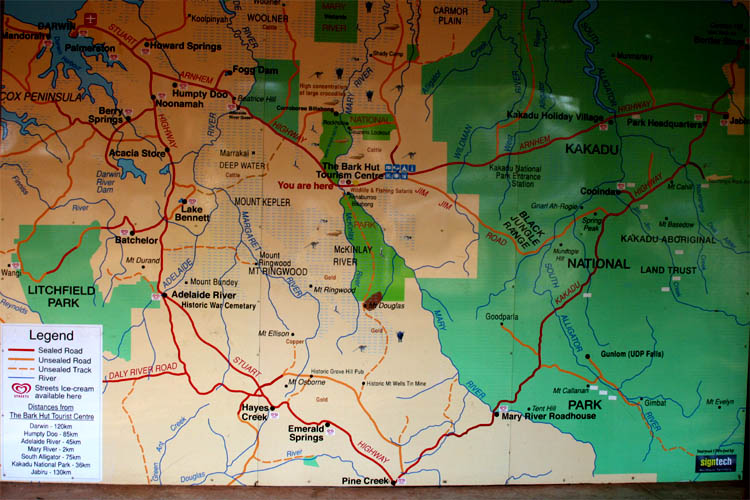
| From Darwin to Kakadu
|
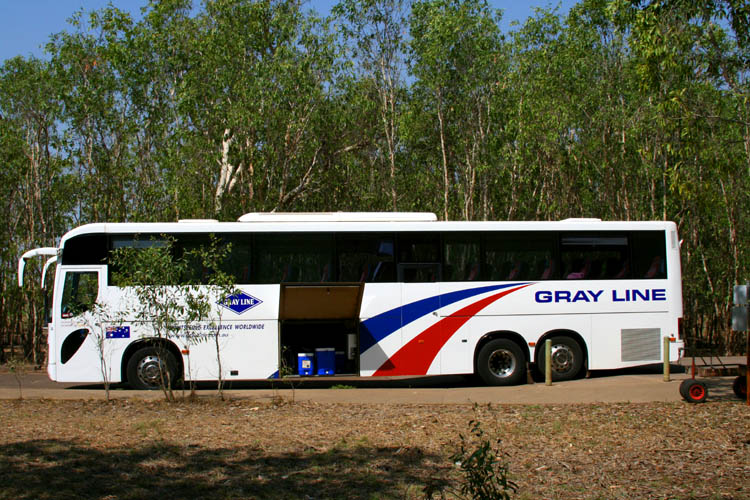
| with the AAT Kings bus
|
Nourlangie
At the Nourlangie Rock we could see one of the most famous ancient Aboriginal rock art in Kakadu. After a short walk from the parking lot (where I had to admire a motorbike: another option to tour Kakadu with), we reached the Anbangbang rock shelter, which has been used for around 20,000 years as a refuge, at least continuously for the last 6,000 years until the time of contact with white people, according to archeological finds.
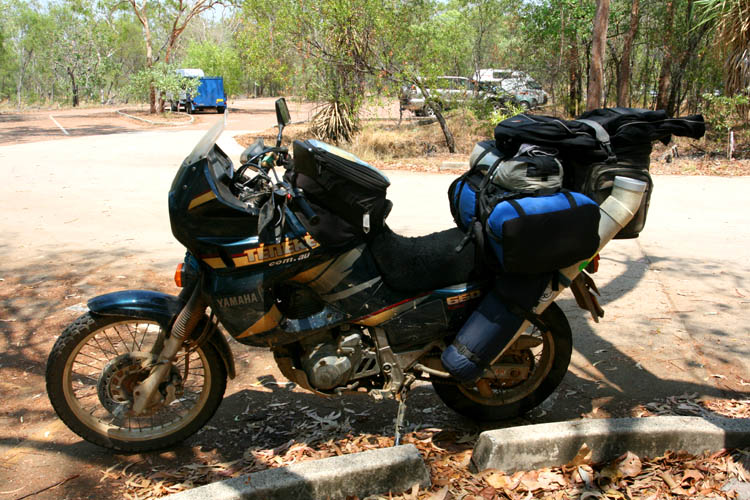
| Touring Kakadu with a bike
|
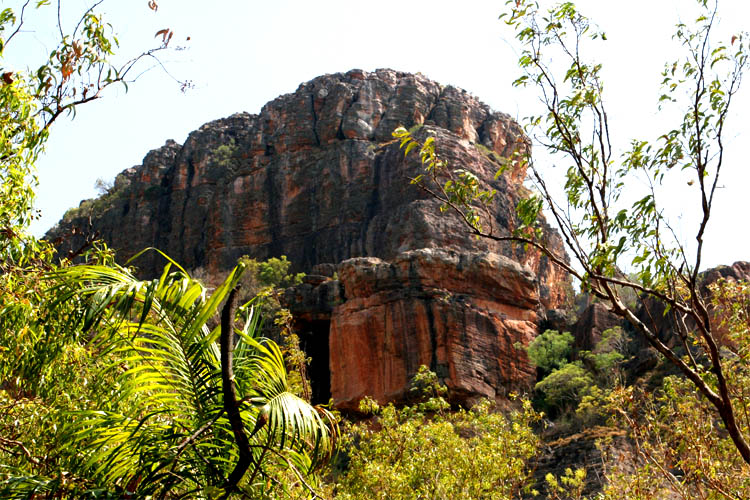
| Nourlangie Rock
|
Then I also had to admire the gallery, of which all paintings were repainted in the 1960s by a famous Aboriginal painter, Barramundi Charly, thus it looked so fresh.
The major character in this gallery is Namondjok, who broke the incest law with one of his clan sisters (can be any woman in the community). His penalty: he became Ginga, the saltwater crocodile. With so many crocs around it must have been very common what he did (and still being done, and worse). On the right of the photo you can see the Lightning Man (surrounded by an arc of lightning).
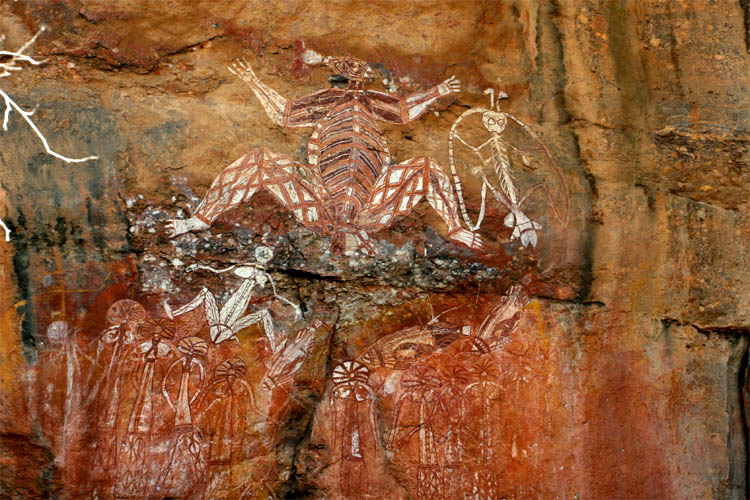
| The big guy in the upper middle: Namondjok
|
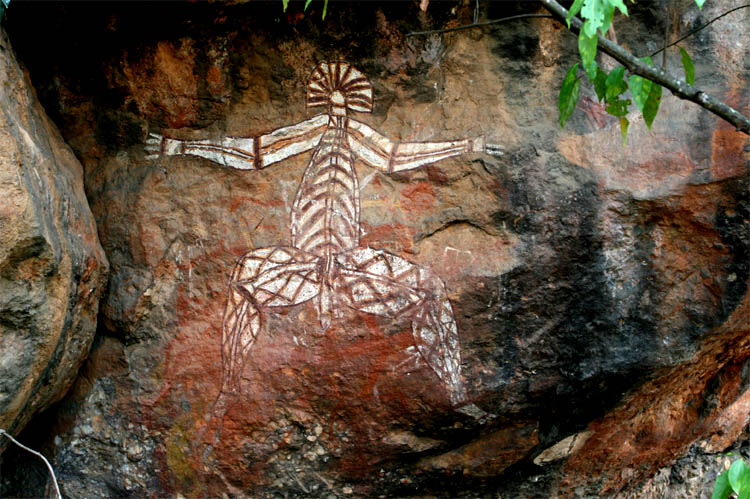
| Maybe the same type in a different style
|
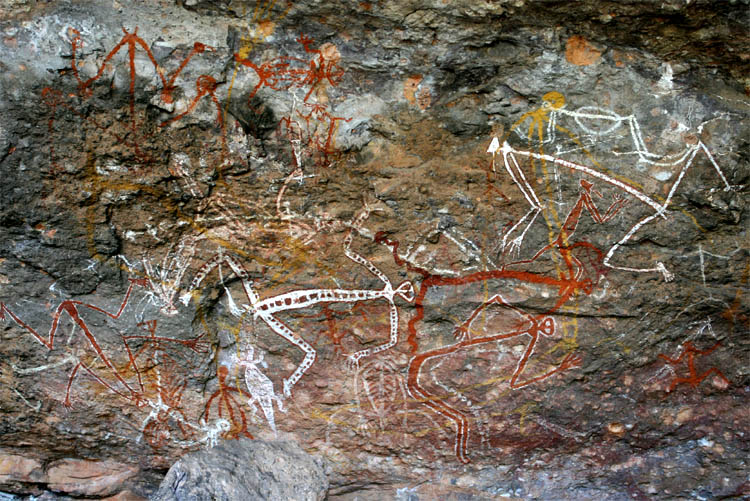
| But what is this supposed to be? Disco Dancing?
|
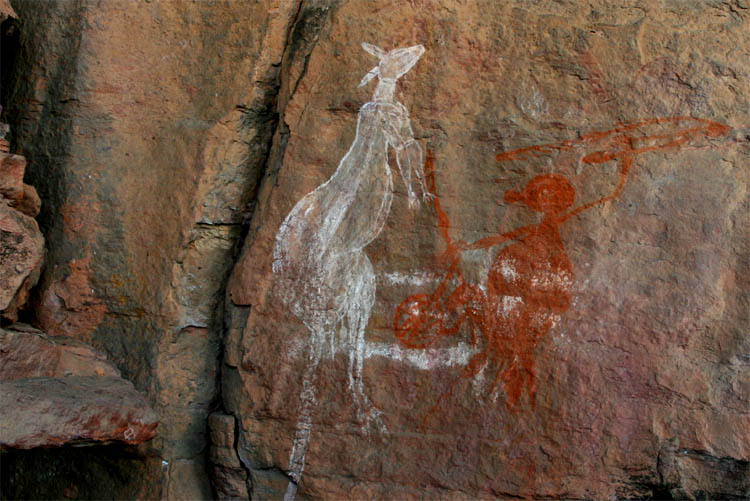
| Only this can be easily recognized
|
Around Nourlangie there are a lot of bush walking tracks. No problem to stay (and walk around) here for a whole day. But we had to board the bus for our next destination.
Cooinda and Yellow Water
Now it was already noon and we had lunch at the Gagudju Lodge in Cooinda (cold lunch but very good buffet with chicken, salad, cakes, fruits and tea and coffee).
Then we did get on a boat for the Yellow Water Billabong cruise through Kakadu's most famous wetland area (boat fare would have been $40).
This really was also one of the highlights and it really was spectacular with swamps, water lillies, bird life and crocodiles. The most dangerous but most impressive saltwater crocodiles hang around here, so don't hang your arms over the edge during the cruise.
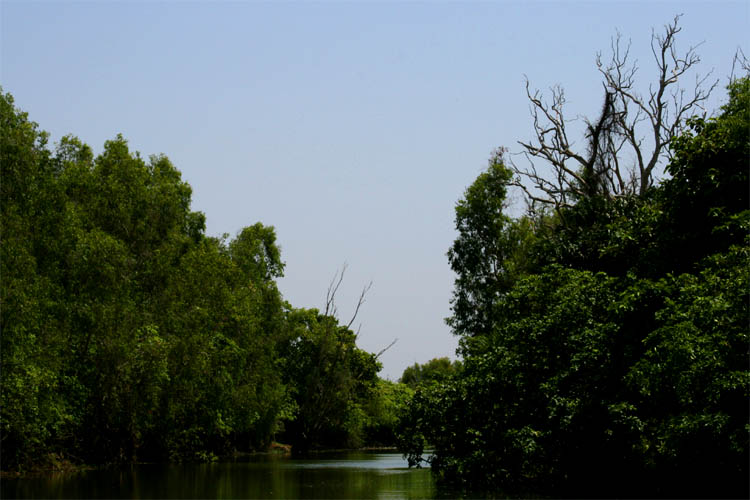
| Yellow Water Billabong
|
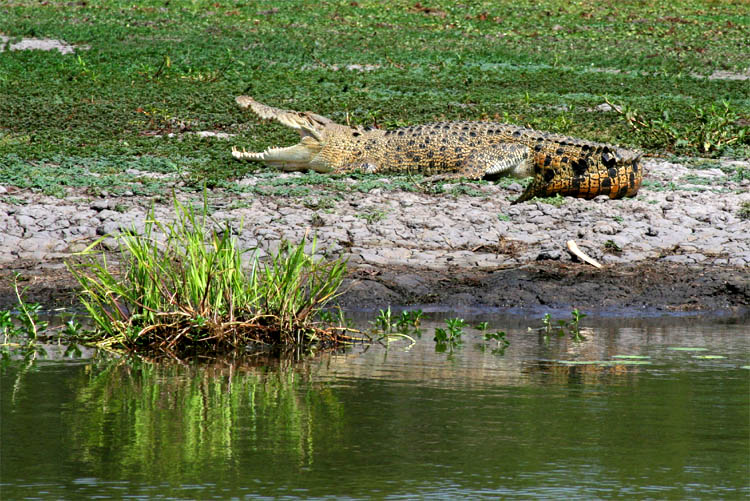
| with my first real wild crocodile
|
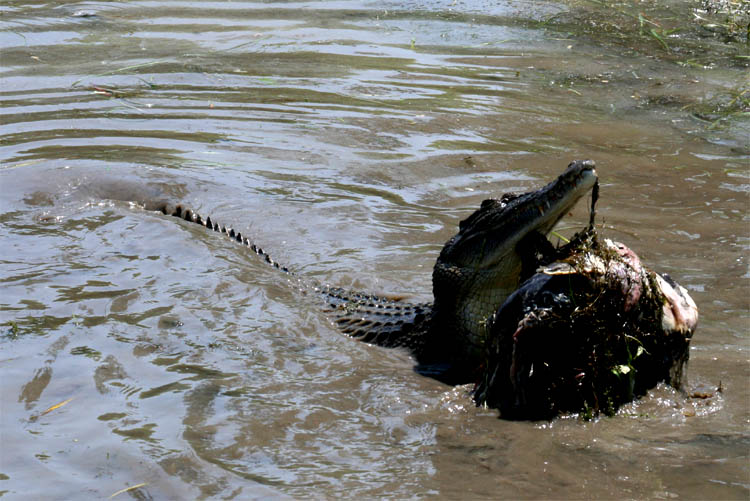
| Too big that chunk to swallow
|
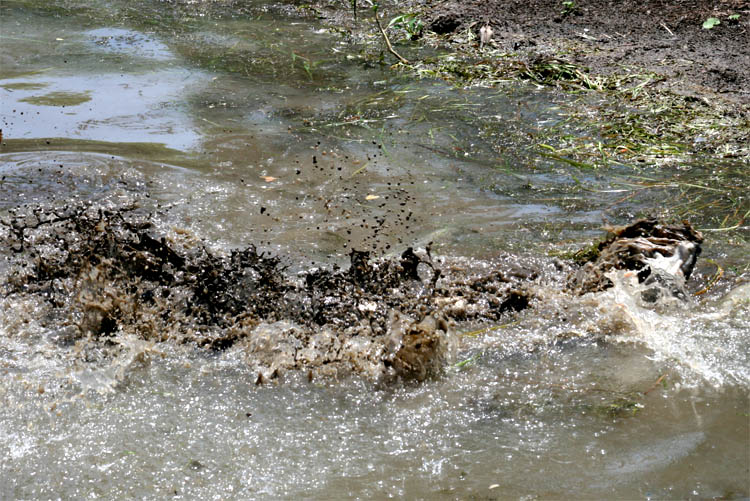
| so it was whirled around to get separated
|
The greatest variety of birds have their habitat here: sea eagles, black kites, magpie geese, herons, brolgas, jabirus, kingfisher, cormorants, ibis and egrets. I only can show a few of them. Look up your encyclopedia to check which one is which.
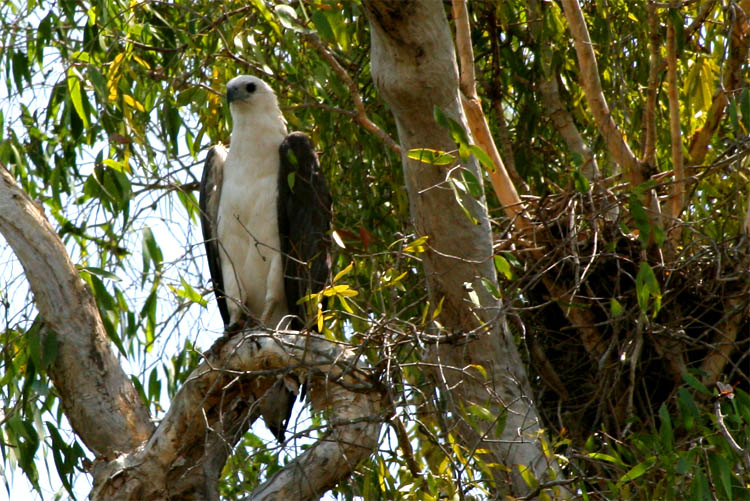
| Sea eagle looking for prey
|
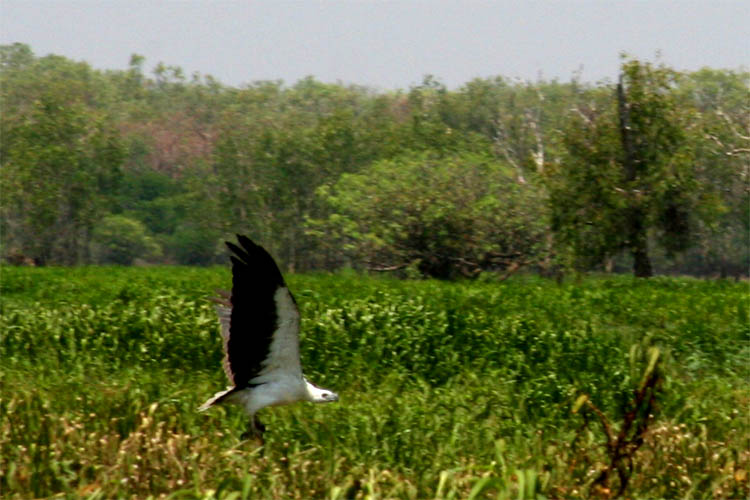
| This eagle just caught a fish
|
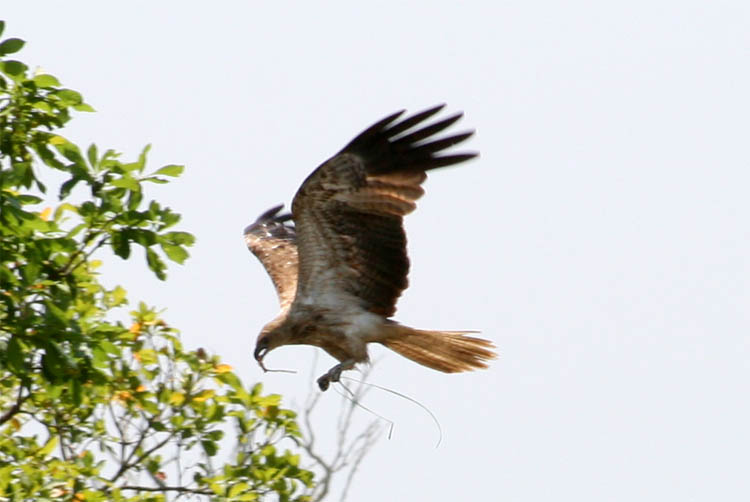
| Black kite building a nest?
|
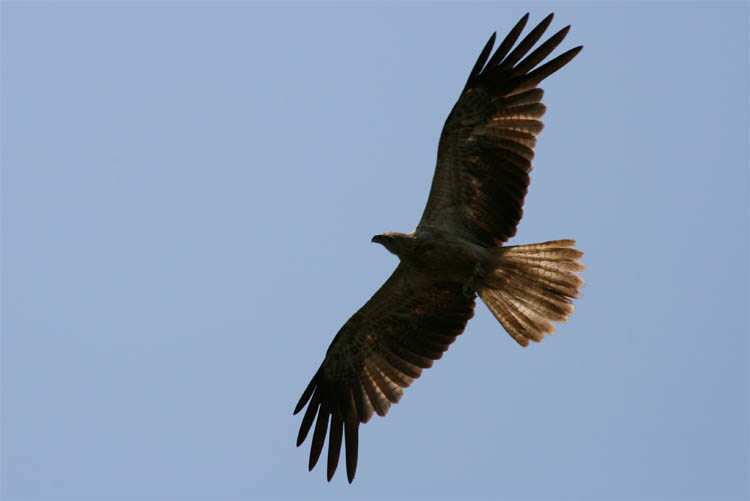
| And they are flying high
|
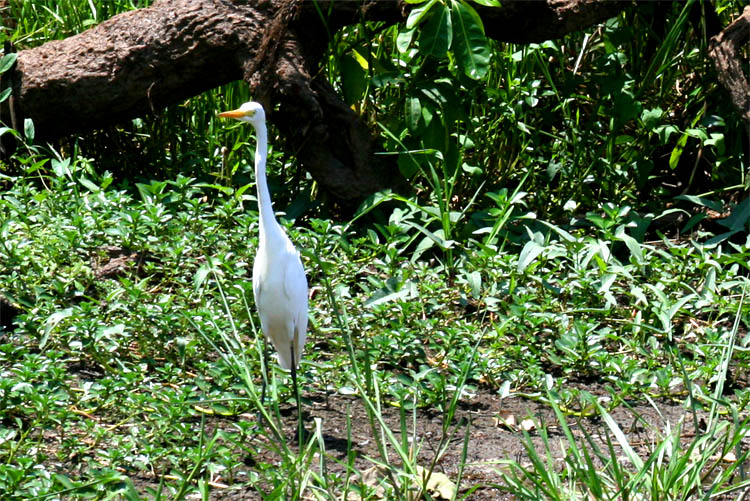
| Is this a darter, the snake bird?
|
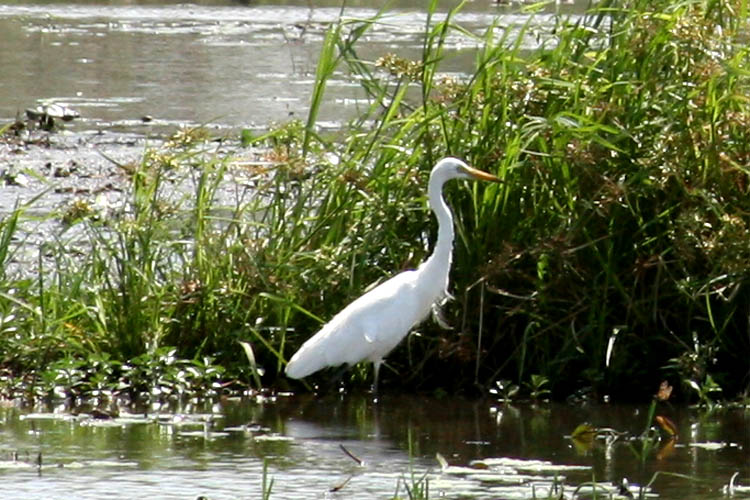
| Because the neck looks like a snake
|
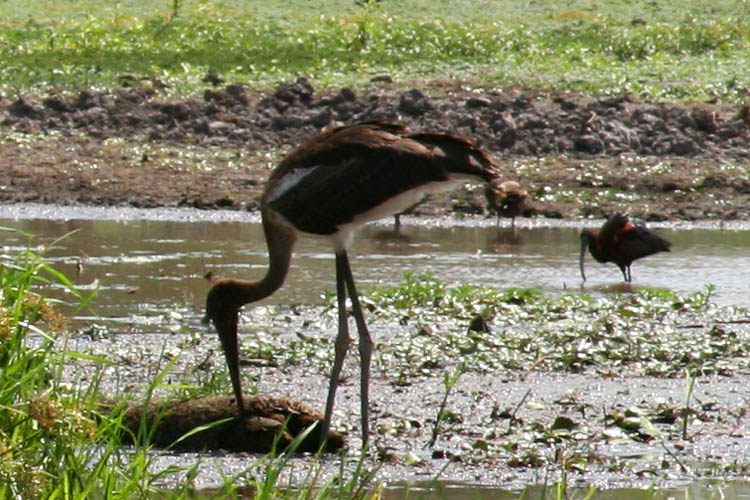
| Looks like a jabiru
|
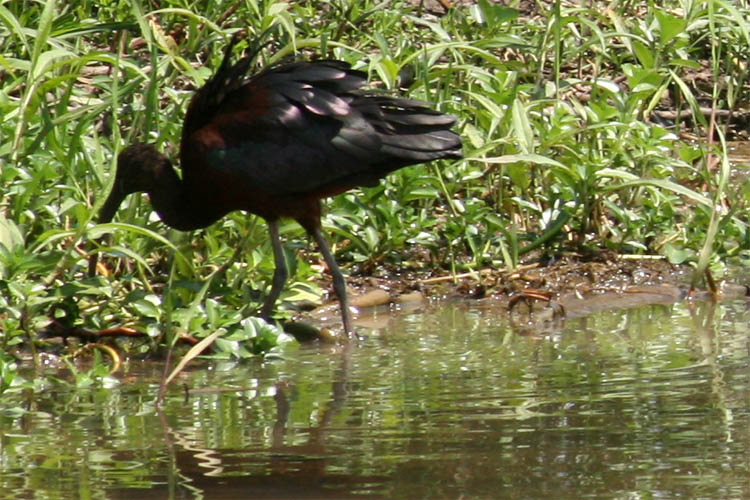
| One more water bird
|
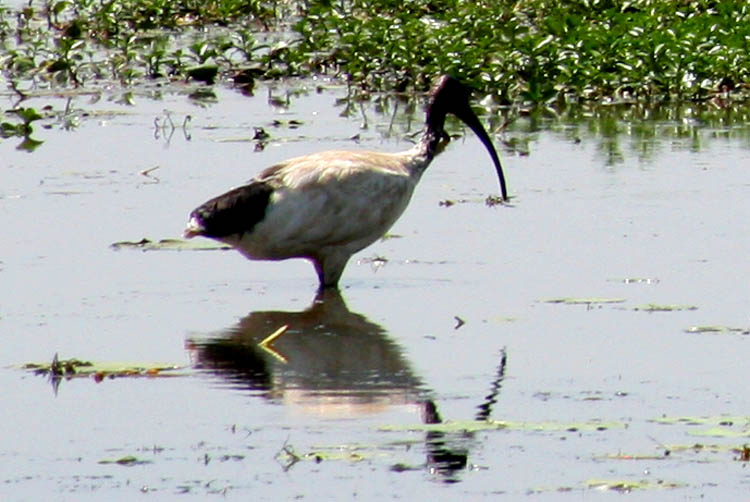
| Or is this an ibis?
|
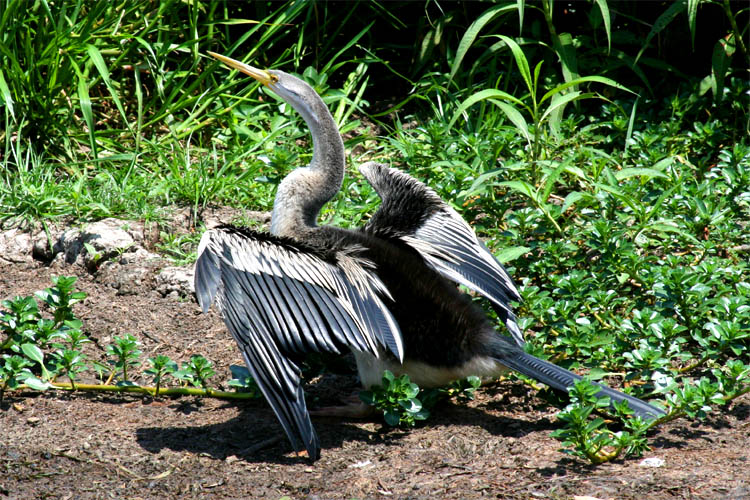
| This looks like a cormorant
|
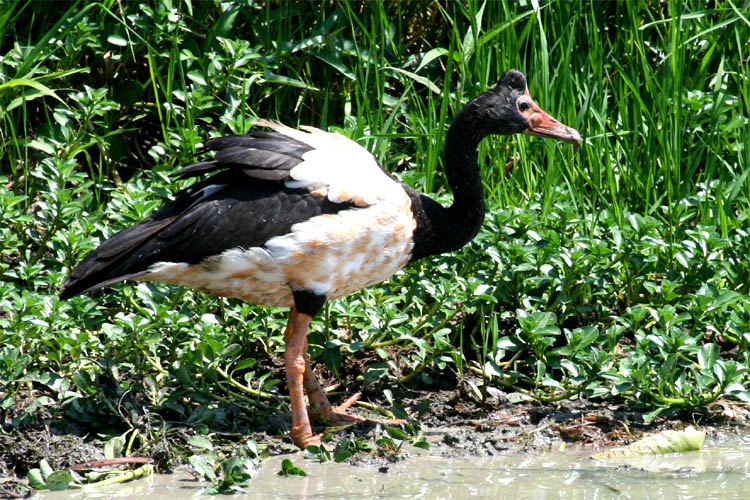
| This is a magpie goose
|
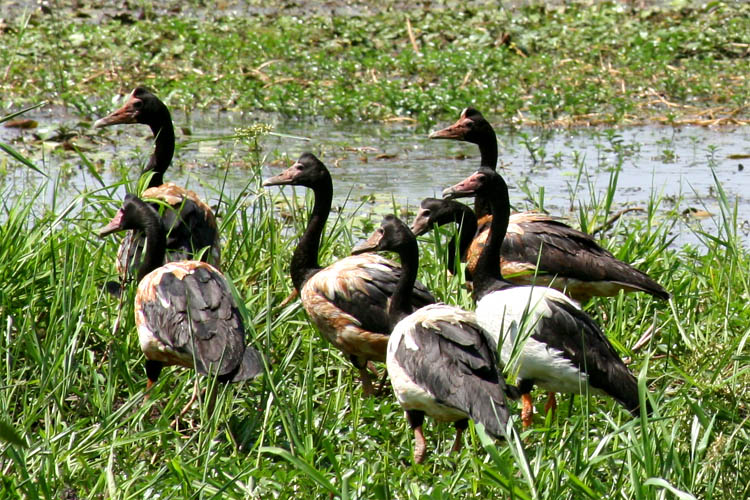
| This is a whole bunch of it
|
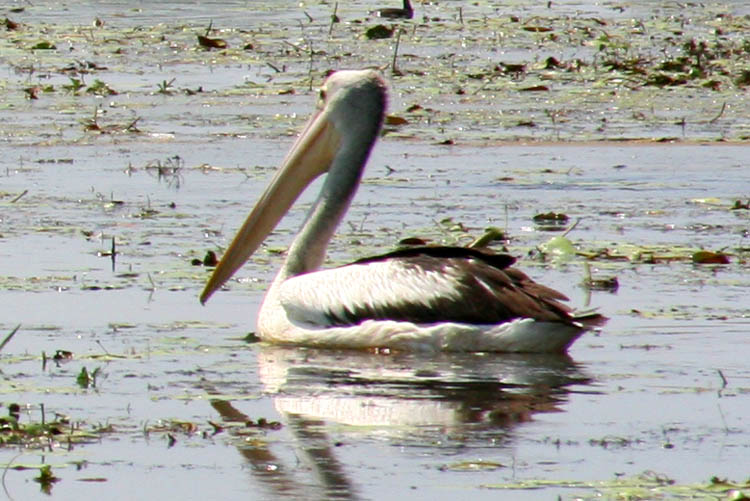
| I know this one: a pelican
|
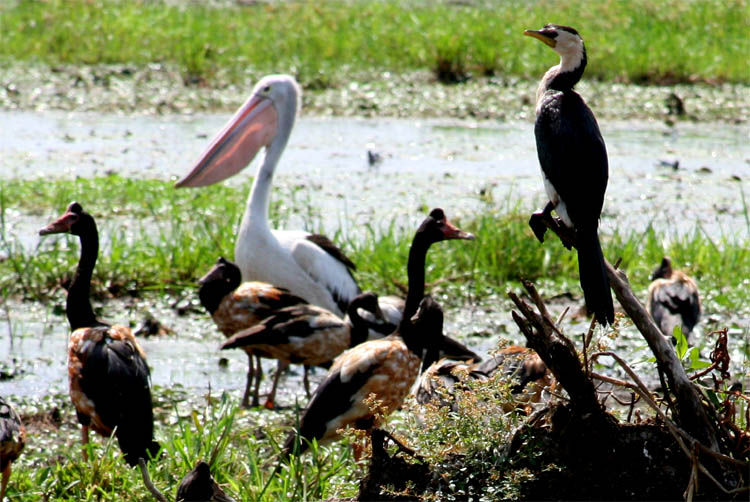
| Three kind of birds together
|
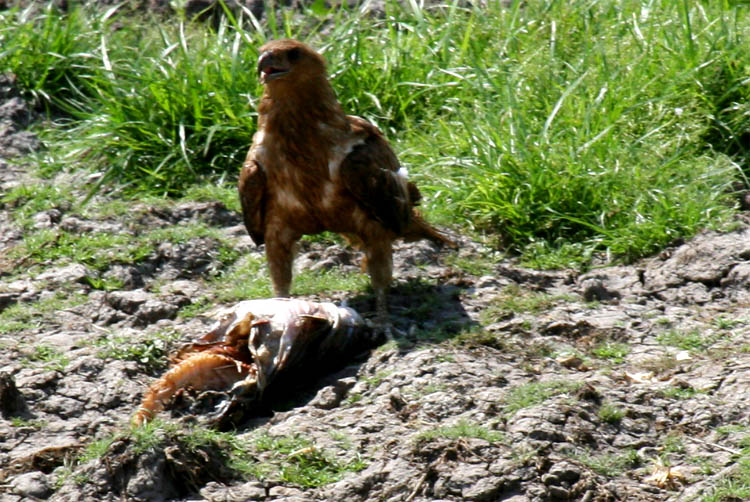
| The buzzard with its prey
|
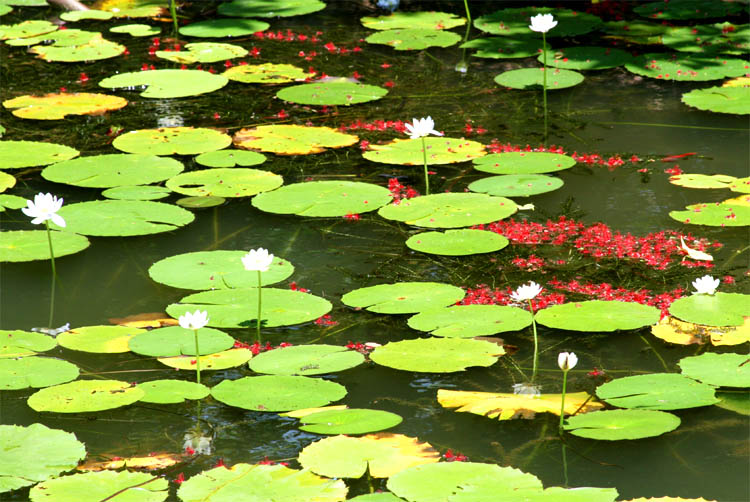
| These are nice water lillies
|
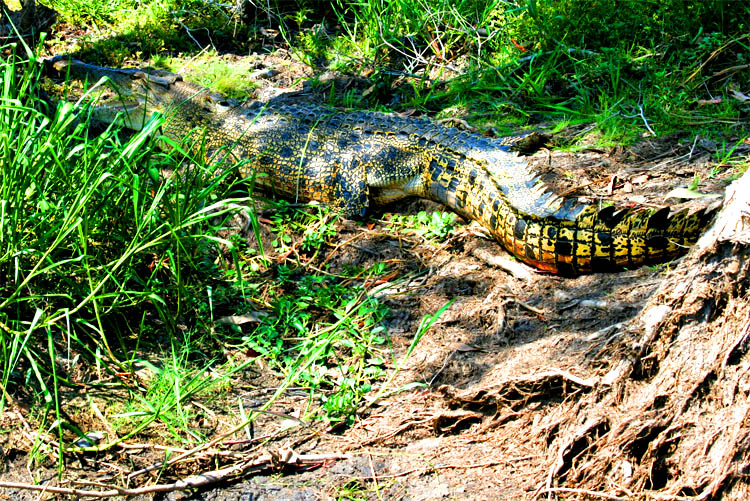
| Isn't this a beautiful saltwater crocodile
|
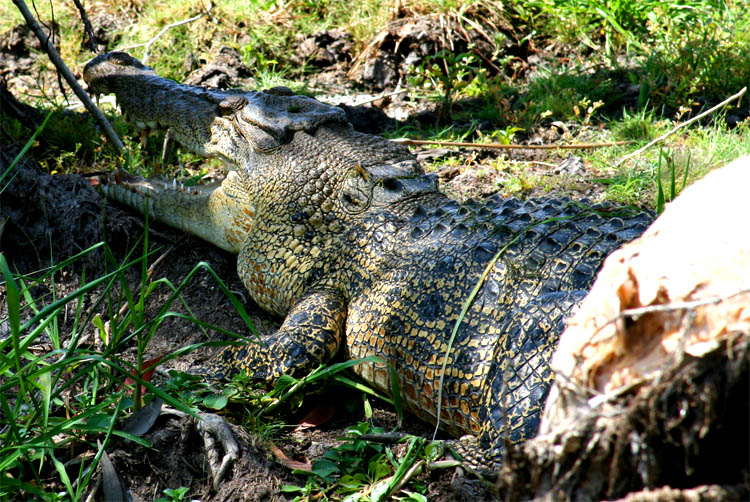
| and this old one really looks dangerous
|
Most of the wetland's billabongs are an angler's paradise. Most (also my) favorite fish is the Barramundi, a fresh water fish, which can grow up to 1.5m long and can weigh up to 60kg. The daily catch per person is limited to five fish (lucky if you caught the big ones). Nearly all Barramundis are born male and become female after around 5 years (half life span?). How about that for human beings?
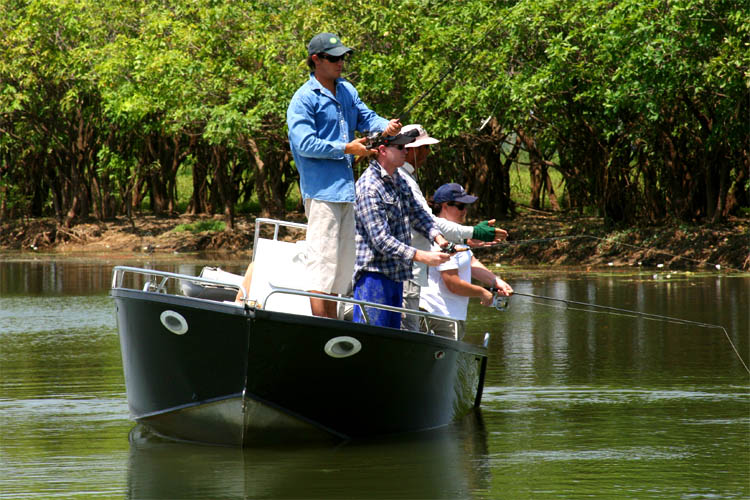
| I wouldn't try to fish here, between crocs
|
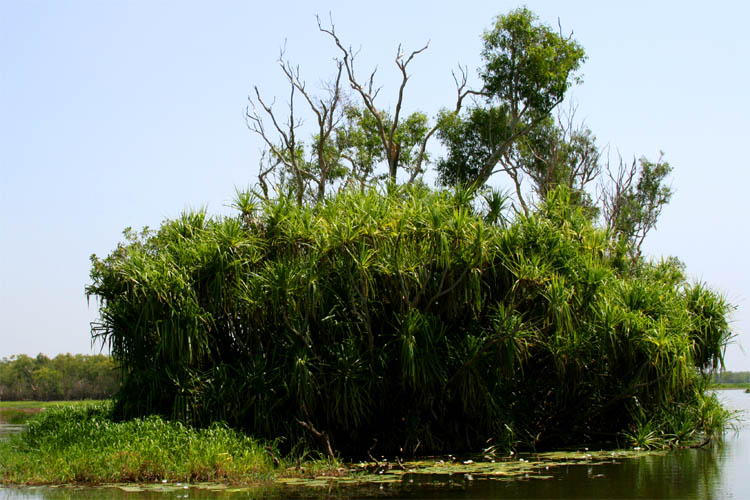
| Crocodiles and Pandanus palms are all around
|
After the cruise we visited the Warradjan Aboriginal Culture Center close to Cooinda. It gave an excellent insight into the culture of the park's owner.
Jabiru
Around 4:30 p.m. I was brought to my accommodation for the next three nights: the
Kakadu Lodge
Jabiru Drive
Jabiru
Kakadu National Park
Tel.: +61 8 8979 2422
Email:klodge@auroraresorts.com.au
|
where I stayed, as part of my tour package, in the so-called "lodge" (actually a 4 bed dormitory, but I had it all for myself). If I would have booked it directly it would have been $141 for the whole "lodge" or $36 per bed. A cabin with bathroom (and even kitchenette) would have been $211. Powered and unpowered campground sites are also available ($20/$25 for two).
Well, I was the only cheap guy to stay here. The other tourists of my bus stayed in the Gagadju Crocodile Holiday Inn for $285 the room (October price, cheaper in December for $160). But I did not like that Holiday Inn: the swimming pool was small and in a court yard surrounded by the room wings.
The swimming pool in the Kakadu Lodge was much larger and nicer, with extra jacuzzy and with beautiful tropical flora around. It had a good restaurant at the pool with good food, but expensive: Barramundi filet with chips and salad for $32 and the beer as usual for $4.50.
The Holiday Inn building was in a shape of a crocodile (only recognizable from the air) and right in the middle of the town of Jabiru, which is the major service center for Kakadu. It has two banks, a library and a public swimming pool beside its obligatory super market, gas station, police station and health center ...with a lot of grass in between occupied again by groups of Aborigines, especially one group of women, each with a pile of dollar bills in front of her, gambling with cards (Aboriginal women generally don't like to be photographed, thus no proof).
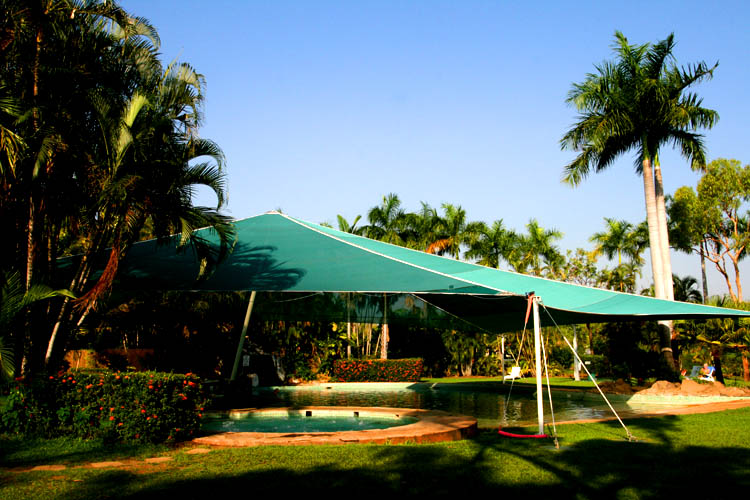
| My overnight place with swimming pool
|
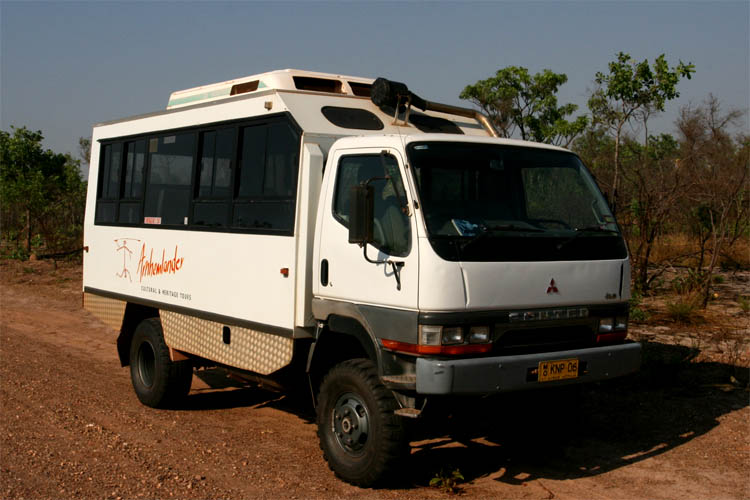
| The "Arnhem-lander Cultural and Heritage Tours" bus
|
Arnhem Land
Next morning I ate my breakfast out of a box, bought the previous day for $12.50 ( the shop opens at 7:30 a.m.) before I was picked up at 7:45 a.m. by Arnhemlander Cultural and Heritage Tours. They are "specialized" (maybe only because they had a permission of the Manilakarr people to go there) on 4WD tours to Arnhemland, east of Kakadu. If not included in my package they would have charged $195 for the tour.
The tour company is 100% indigenous owned and it also advertises indigenous tour guides, though indigenous tour guides may not always be available. And so it was.
Ok, it was a special service that we only had to wait 30 minutes to get another 4WD after our vehicle broke down soon after we left Jabiru. Our driver lady (and guide) was trying to fix it but in vain.
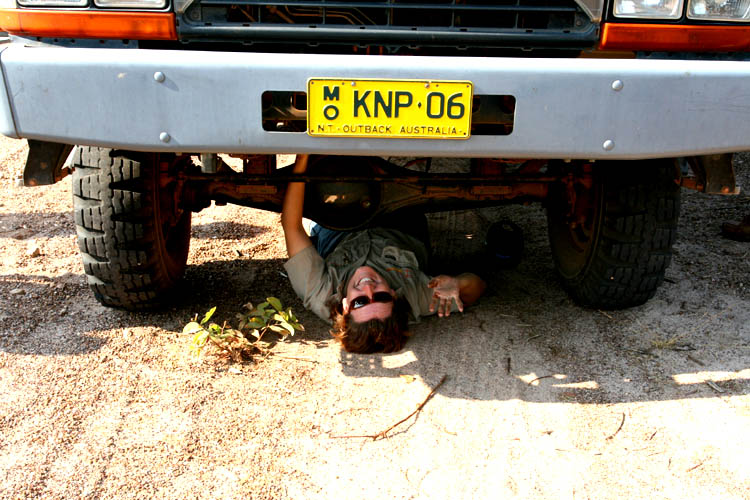
| Engine, no nervous breakdown
|
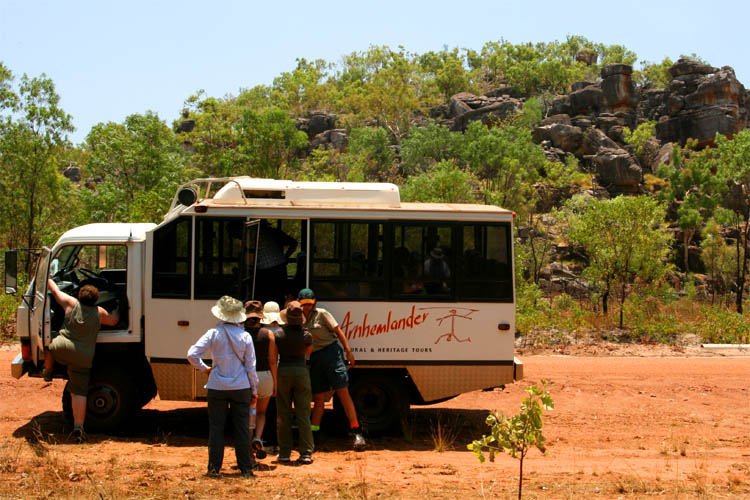
| Our substitute 4WD bus arrived quickly
|
Soon we reached Arnhem Land by driving through the East Alligator River at Cahill's Crossing. Stopping at this point and getting out and over by foot to make some photos, would be very deadly. One father who did so and slipped a couple of years ago, was decapitated by a crocodile while being watched by his wife and son. So I took the one photo rather from the inside through the window. Also getting close to any water, like a billabong, is dangerous here.
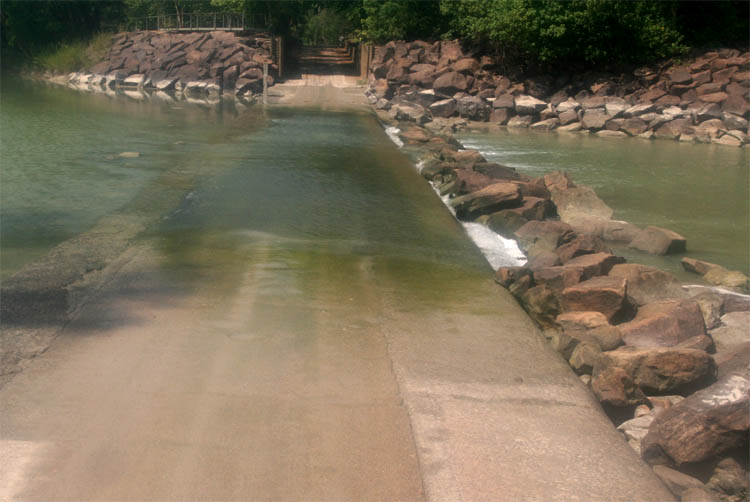
| East Alligator River crossing to Arnhem Land
|
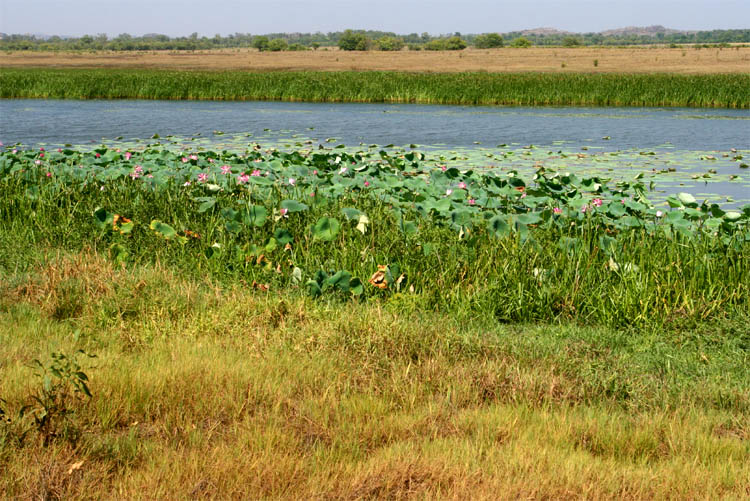
| Nice billabong, but maybe dangerous
|
Now we are in Arnhem Land (actually not part of the Kakadu National Park), also called "stone country", because of its escarpment (eroding sandstone hills). The landscape is thus spectacular, and a vast, almost untouched area (with a size of Victoria and bigger than Bavaria), with few people (around 20,000) living there.
And where you see a lot of rocks you also find many rock art sites.
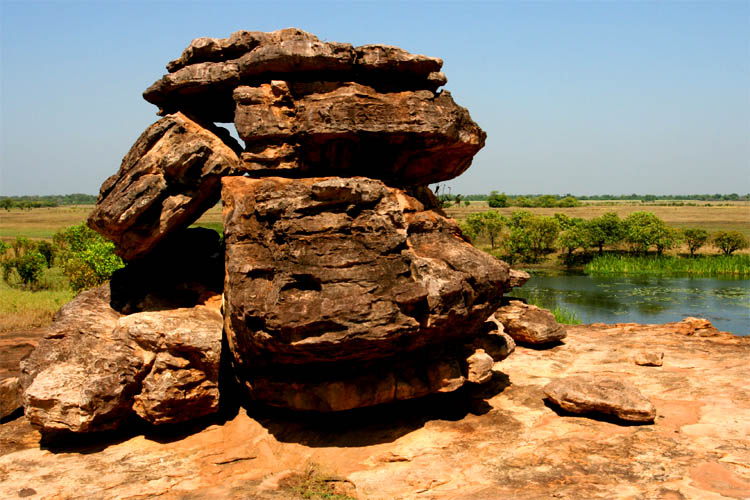
| Who has placed that rock?
|
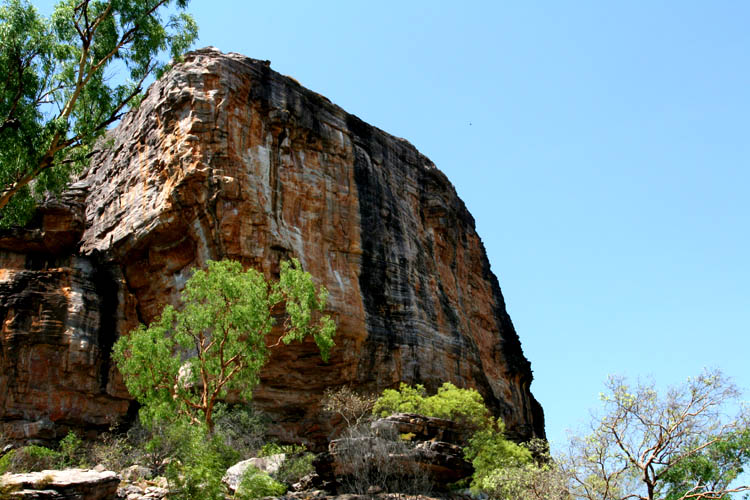
| One of the rocks with rock paintings
|
One of the highlights of this trip was to see the rock painting of a Mancassan ship from Indonesia. The Mancassan came from Celebes (Sulawesi), who did some trading with the Aborigines of Australia at the time when no white men has shown up yet. This painting must have been created at a time when ships like that were build in Indonesia (logical), around 200 to 400 years ago.
The next photo shows a design of a strange animal just painted on the floor of the painting area of the Injalak Arts &Crafts Center coming next.
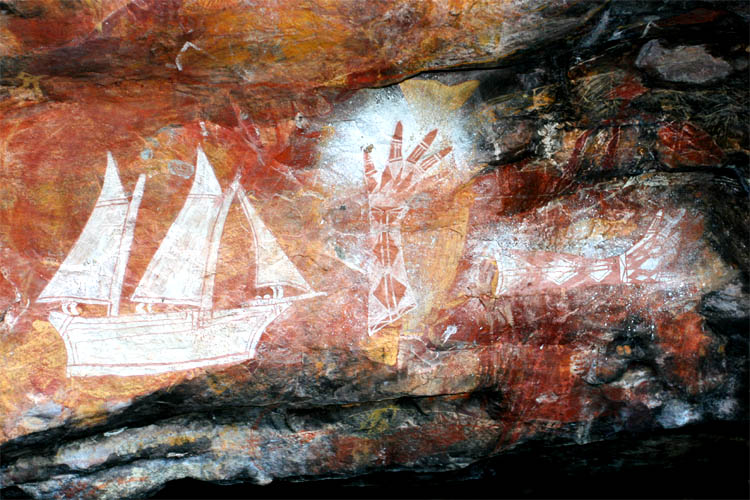
| The famous rock painting of the Mancassan ship
|
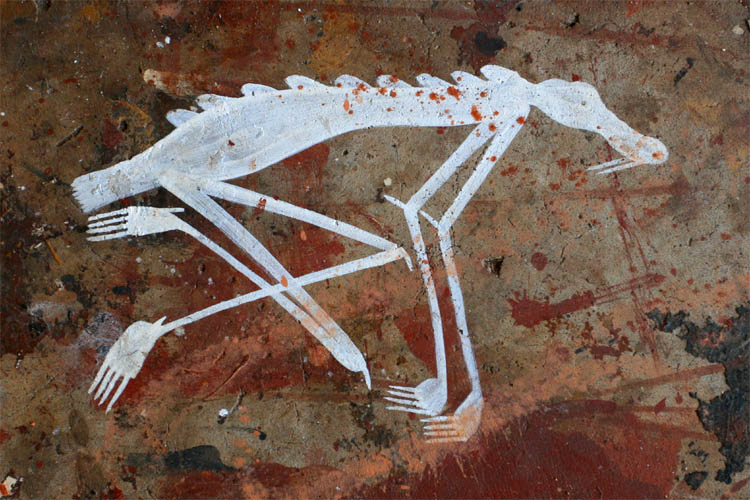
| This strange animal is no rock art but floor decoration
|
The most sad thing was meeting the Aborigines in their settlement Gunbalanya (Oenpelli), just 17km into Arnhemland. I didn't understand why a permit was needed to visit this place, where the main purpose was to sell their products (weavings, baskets, printed fabrics, didgeridoos, paintings) at the Injalak Arts &Crafts Center, where we also stopped just right in front of it. Ok, according to the tour's brochure we were also guests here of the Bunidji people (not only potential buyers).
I have read in a guide book that there will be an Oenpelli Open Day once a year, which gives visitor a chance to buy their local artifacts and watch sports, concerts, and dancing events, and all that without a permit!
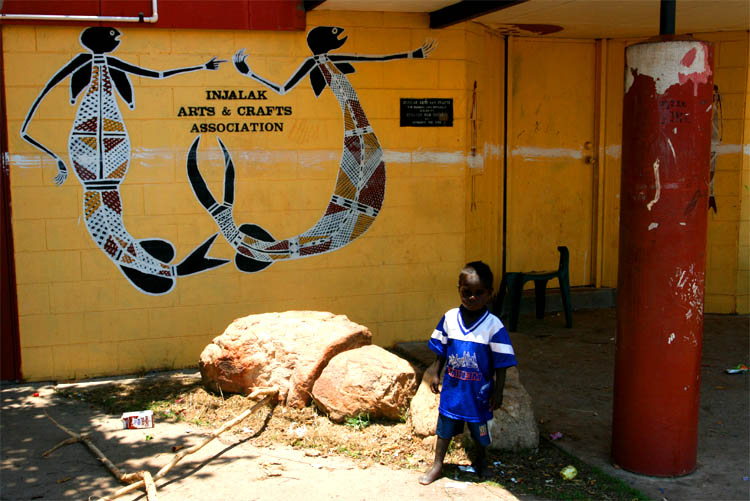
| At Injalak Arts & Crafts Association
|
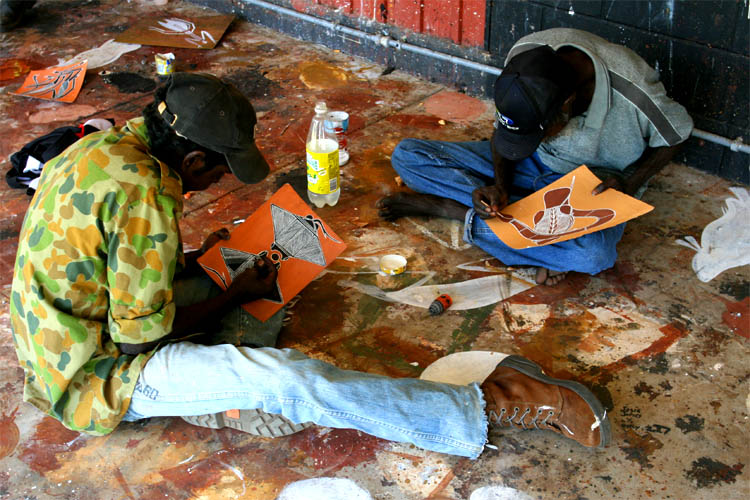
| Painters at, not very comfortable, work
|
For me everything here was overpriced, but it was supposed to be really wholesale, for example $60 for a small weaved basket where the retail price was double at the Holiday Inn in Jabiru. And also, except for the painters (who are working only in the morning, I was told), I saw nobody else producing any of the other handicrafts. In the back office of the shop only two white ladies were doing some paper work.
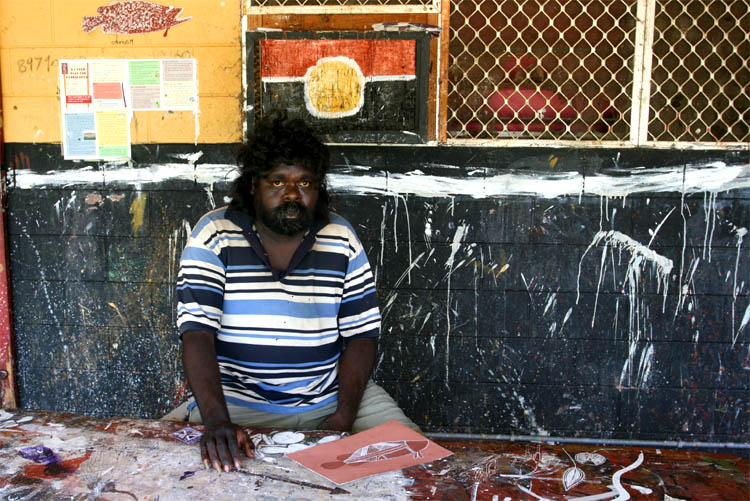
| Other indigenous painters
|
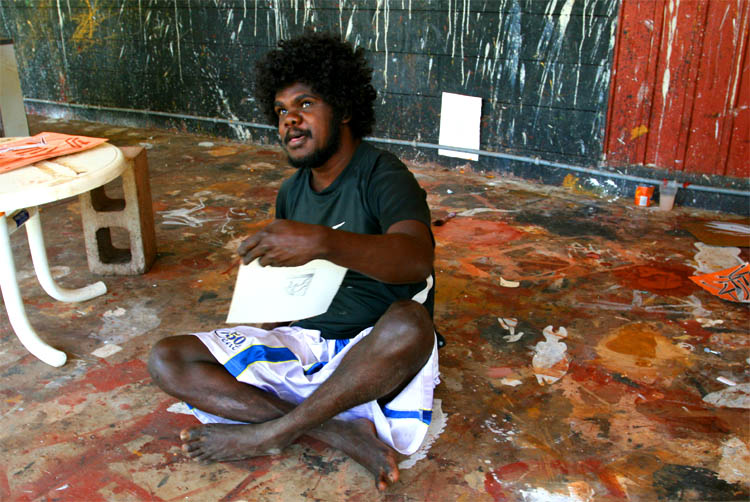
| the only busy people around
|
There was not much else to see in the village. Similar houses all around as in most Aboriginal settlements, with the same filth, with garbage lying around everywhere, but not that many scrap cars in the front yard, because there are not that many cars around in whole Arnhemland anyway.
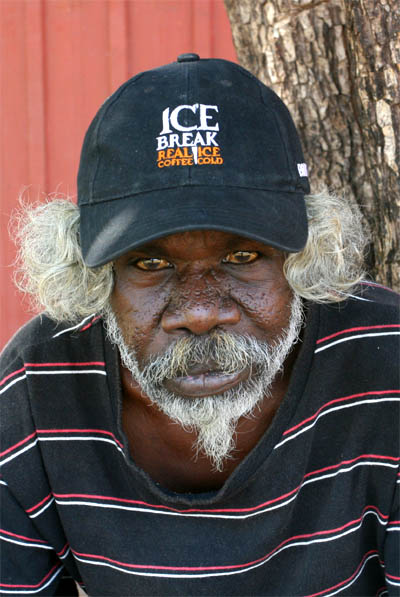
| He was not busy, maybe the chief
|
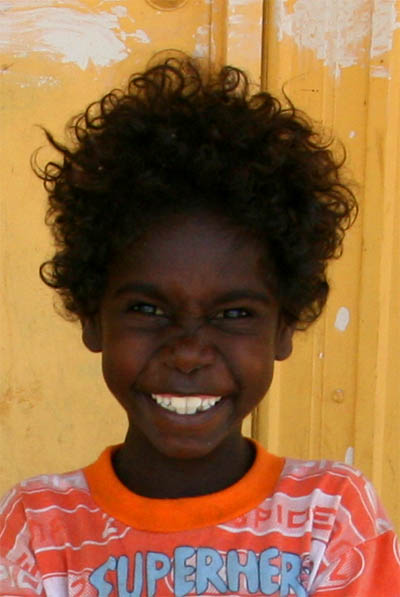
| So was the kid just playing around
|
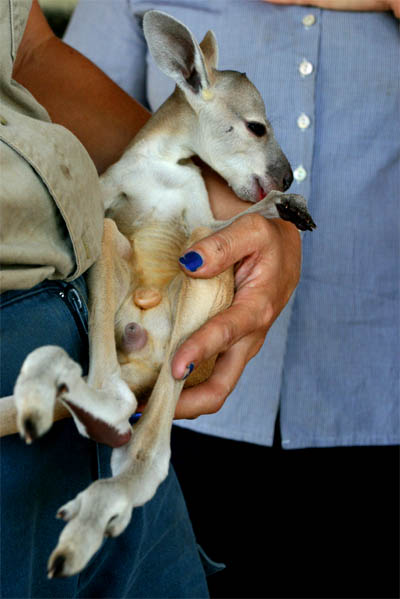
| The little wallaby rather wants to jump around
|
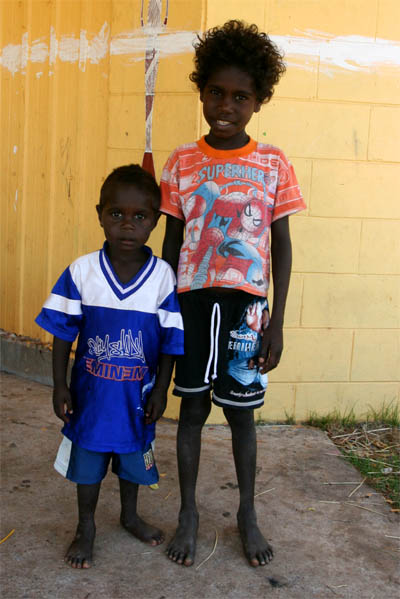
| and here the kids have to stand still (for the photo)
|
Our tour was supposed to be accompanied by an Aboriginal guide, but our lady guide did nicely all of that: driving, explaining, trying to fix our 4WD and ... climbing (but fell down a rock and hurt herself slightly). It seemed that no Aboriginal guide was available (as already implied in the brochure).
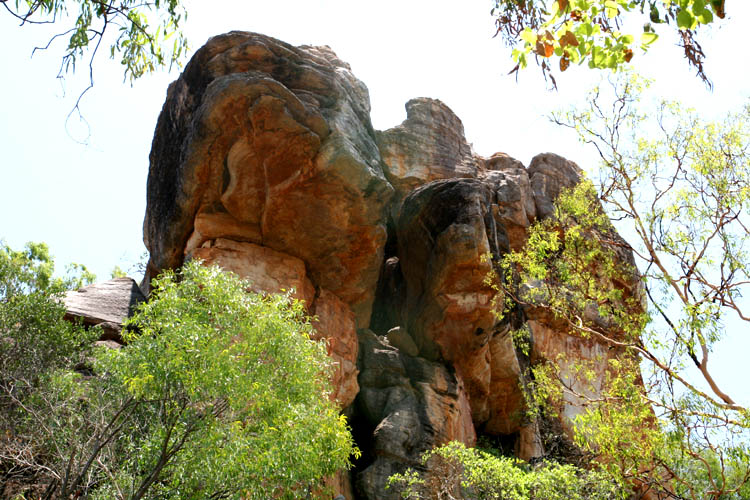
| Another rock
|
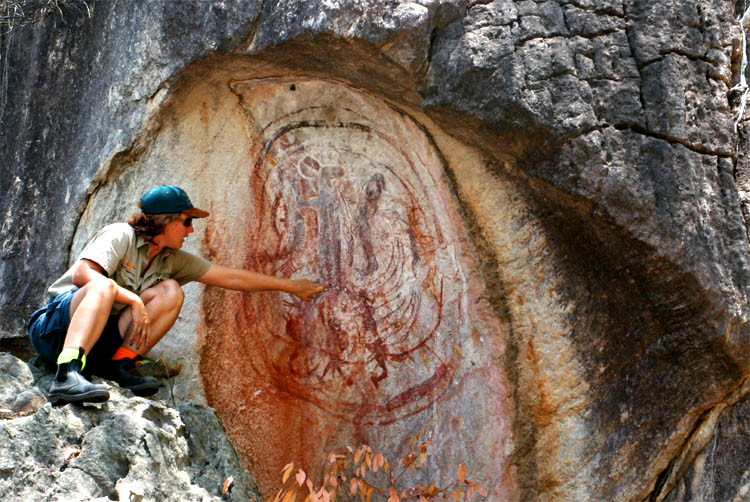
| with real old rock paintings
|
The landscape is fantastic with the sandstone outcrops, some just popping up in the forests and floodplains.
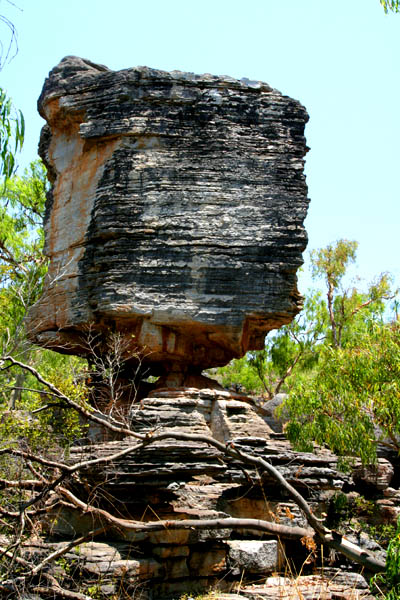
| Very strange rocks
|
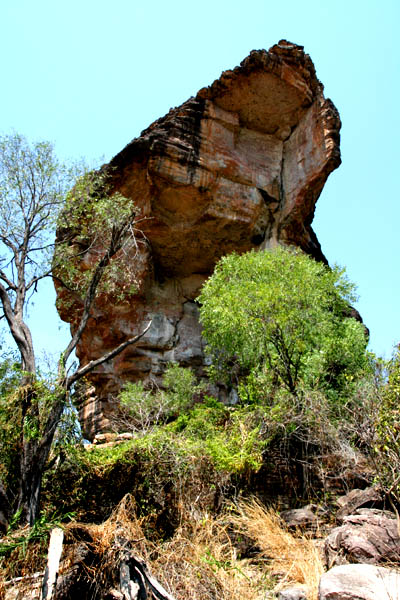
| Who has build them?
|
Then we had picnic lunch (not real bush tucker, though) under a tree with a nice view over the floodplains. After that we also learned something about bush skills like hunting, food gathering and bush tucker (food) preparation and practiced some spear throwing, which was not easy because of the special hooked rod to accelerate the spear.
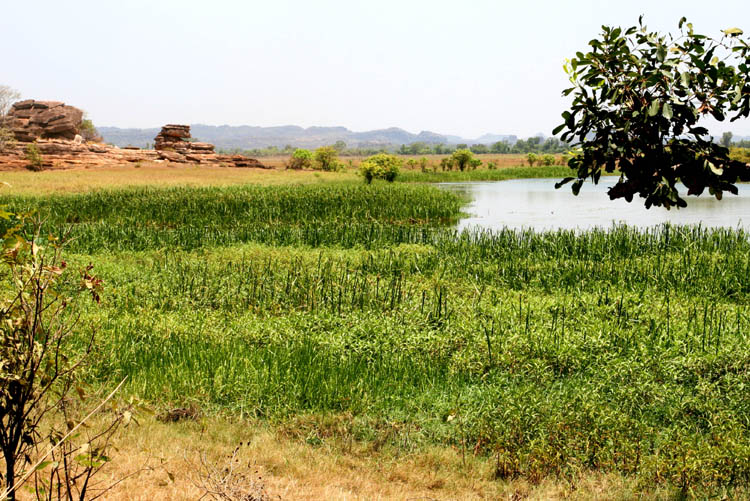
| Lunching at a nice resting place under a tree
|
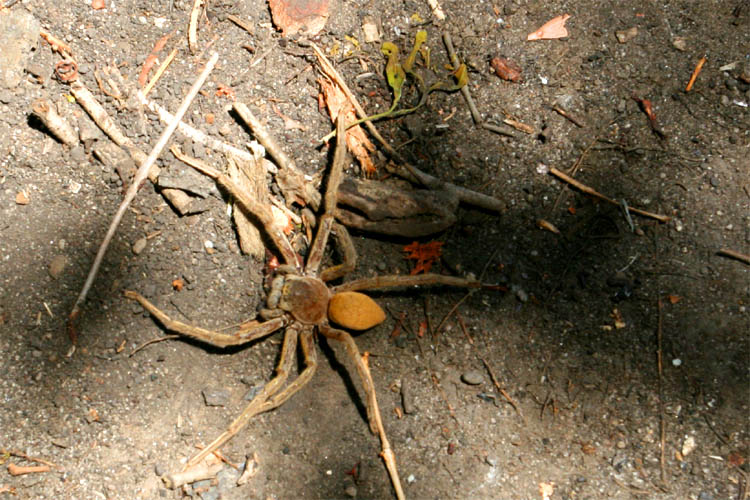
| with a spider falling down from it into a lady's blouse
|
The last stop was at a beautiful looking billabong (Was it the Mikinj Valley? The Crocodile Nest?), inviting for a swim. But beware, this really seemed to be a dangerous place. Our guide advised us not to get too close to the water's edge, though we neither saw a croc nor any eyes looking out of the water. She even called back a guy from another group, who was wandering up the shore, and maybe saved his life.
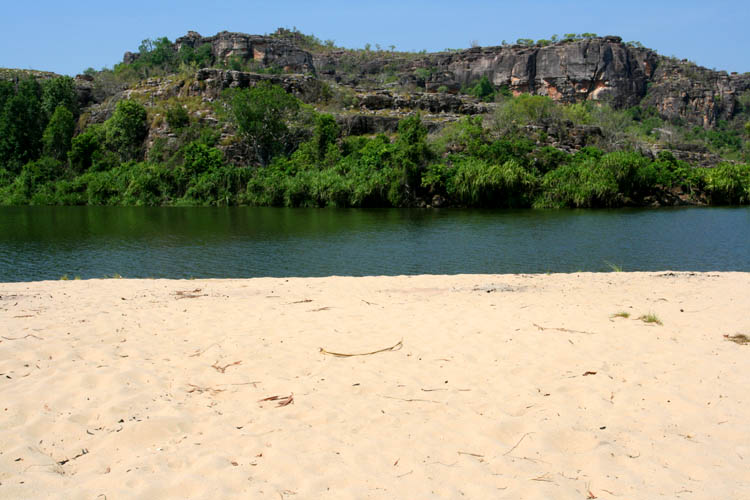
| This is a billabong with a nice white beach
|
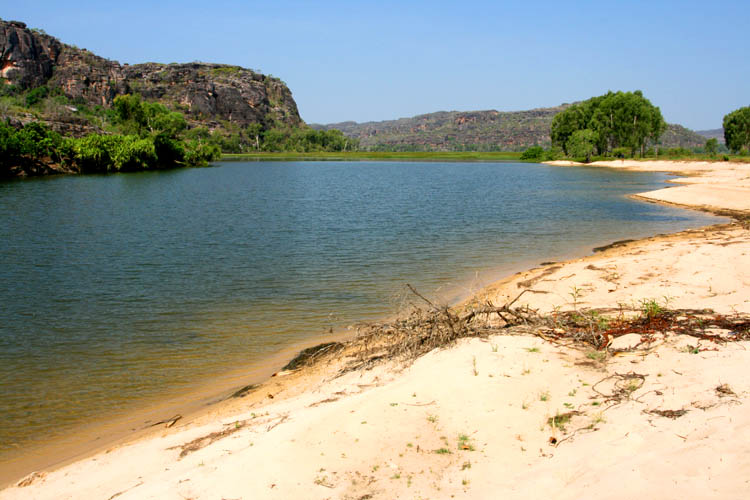
| with crocs around looking for human prey
|
Twin Falls and Jim Jim Falls
Next day's pick up was even earlier at 6:45 by the Gagudju Dreaming Tour (www. gagudju-dreaming .com) with a Landcruiser going now to the Twin Falls and the Jim Jim Falls. I didn't know how much they would have charged, but one offer of another tour operator for a similar trip, Graeme Trail, was $160.
Again: the Gagudju Dreaming company is 100% indigenous owned and it also advertises indigenous tour guides, though Aborigines may not always be available. And it was not, but a white guide and driver, Kevin, who was very talkative and thus explained a lot during our trip. Further on, I was accompanied by two Aussie couples.
The first 50km south on the sealed Kakadu Highway was boring until we turned left into a dirt unsealed road which was now leading through savannah woodlands towards the edge of the Arnhemland Escarpment. Kevin switched on the 4WD and with 100km per hour (only 60 were allowed) he drove another 50km until the Garnamarr picnic area where a real rough winding track (with bump holes, soft sand and water puddles) branches after 8km to the right for the Twin Falls (left leading to the Jim Jim Falls). That was a real 4WD experience.
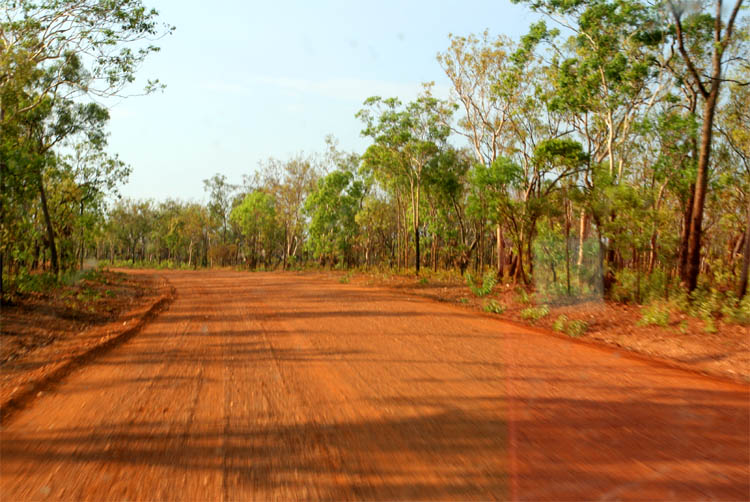
| The road to Twin and Jim Jim Falls
|
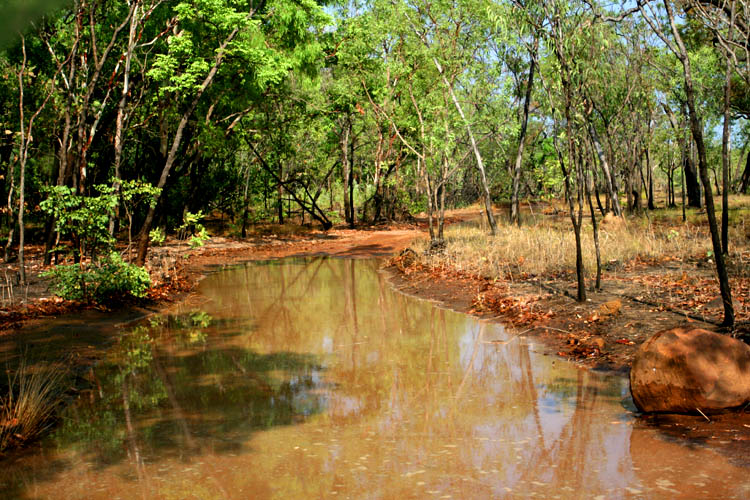
| getting rough after Garnamarr
|
After another 10km we reached a parking lot, where we had to park our car and cross the Twin river on a croc proof pontoon bridge by foot and board a shuttle 4WD to go another few km to get to a jetty where a boat was already waiting to bring us as close as possible to the Twin Falls.
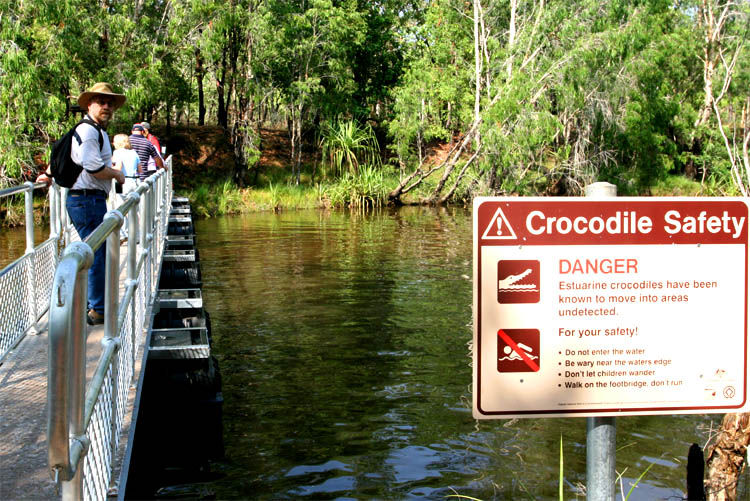
| Crossing the Twin river
|
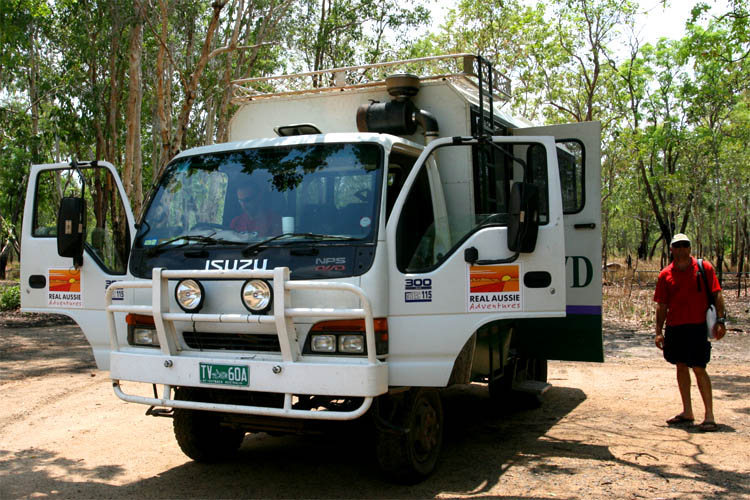
| Changing horses: another 4WD
|
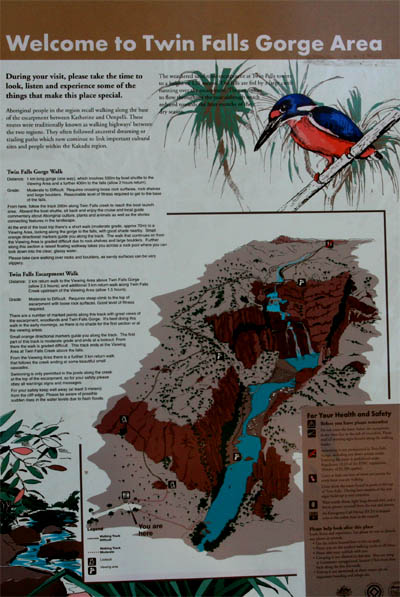
| First sign of the Twin Falls
|
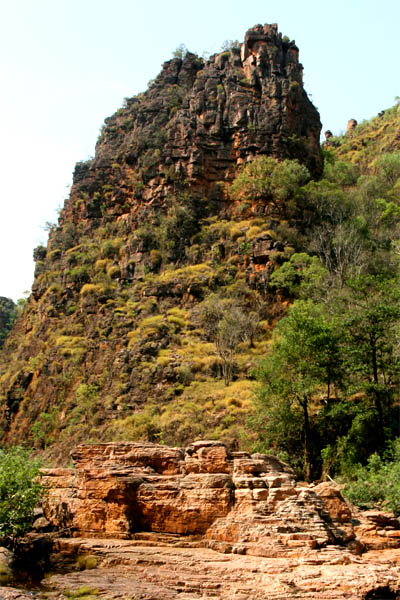
| with rocks getting closer
|
Then a 500m walk over rocks to the base of the fall. Beautiful, but dangerous, because of crocs. Though we did not see one. There were supposed to be three of them. Park Rangers, however, try to keep it free (by having them hauled out to another place by a chopper), but crocs may always come back. You never know.
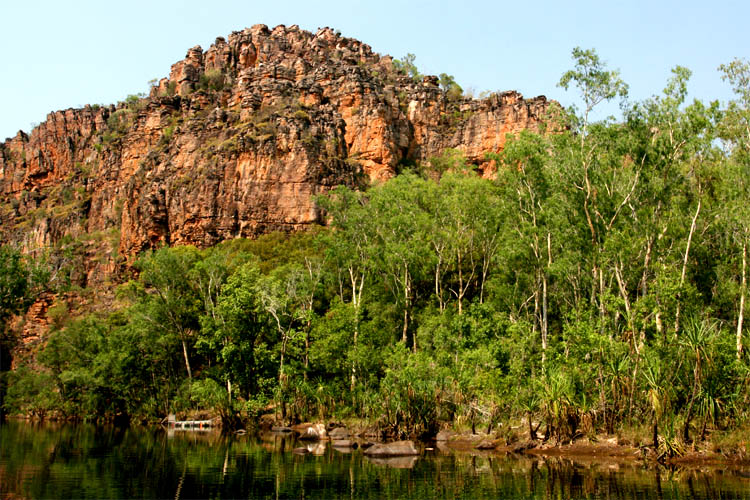
| Beautiful landscape
|
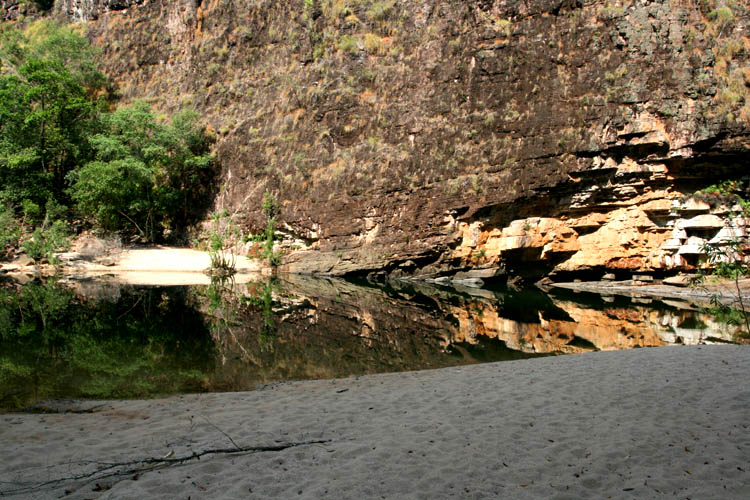
| but beware of crocs
|
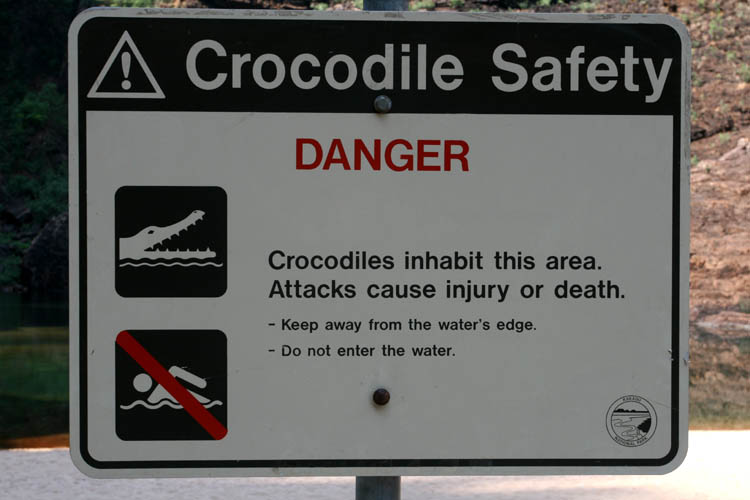
| Here is the sign if you don't believe me
|
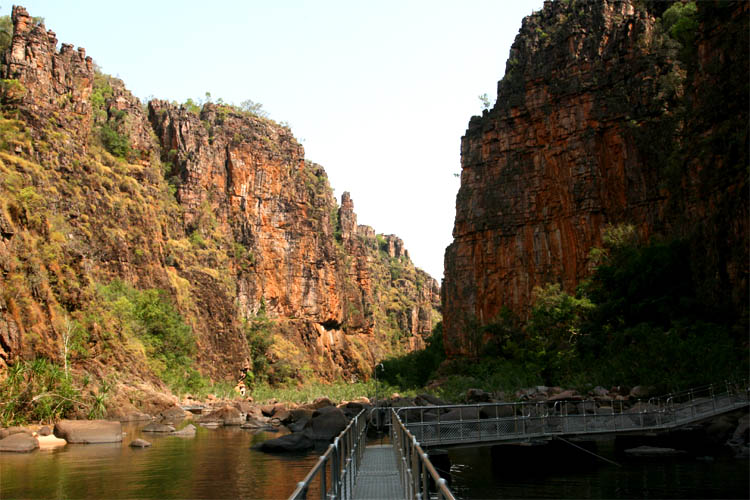
| but you are save staying on the protected walk
|
Finally we reached the pool with an inviting sandy beach. The waterfall was just a rinse, but in the wet season it is a torrent fall and not accessible except if flying over.
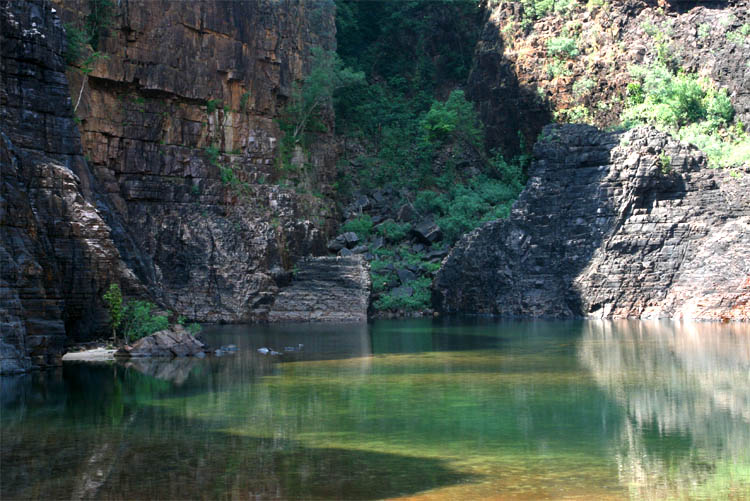
| Finally reaching the Twin Falls pool
|
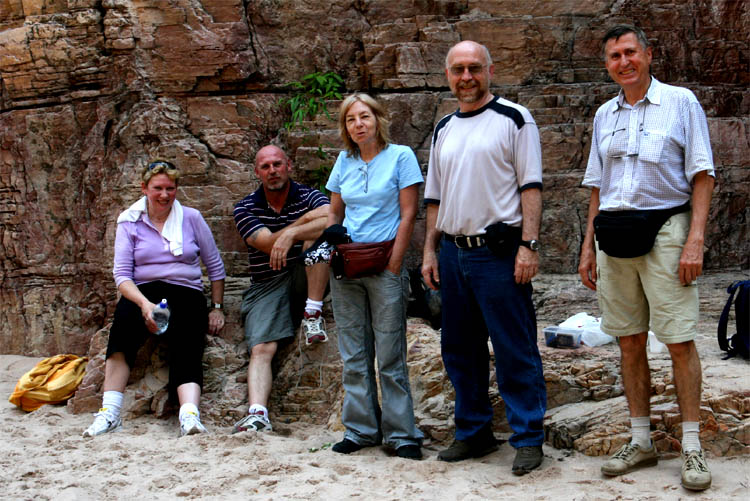
| with my Australian companions
|
One couple was from Adelaide (lady's grandfather came from the Black Forest in Germany) and the other came from Brisbane (the man's grandmother came from Holstein in Germany).
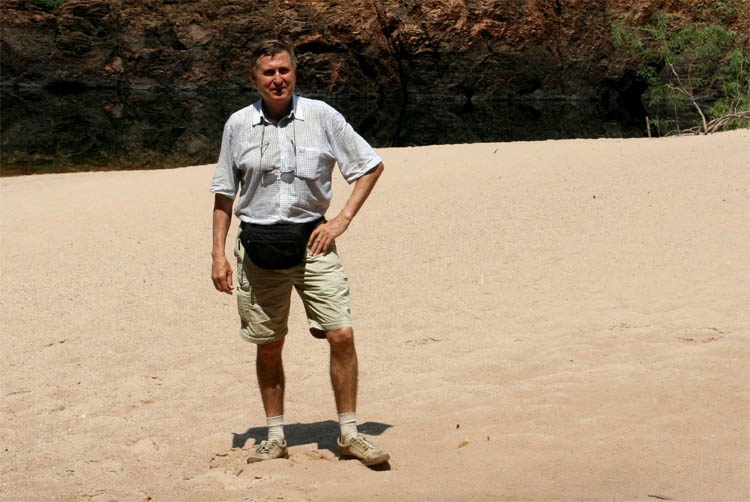
| Not afraid to be attacked by a croc
|
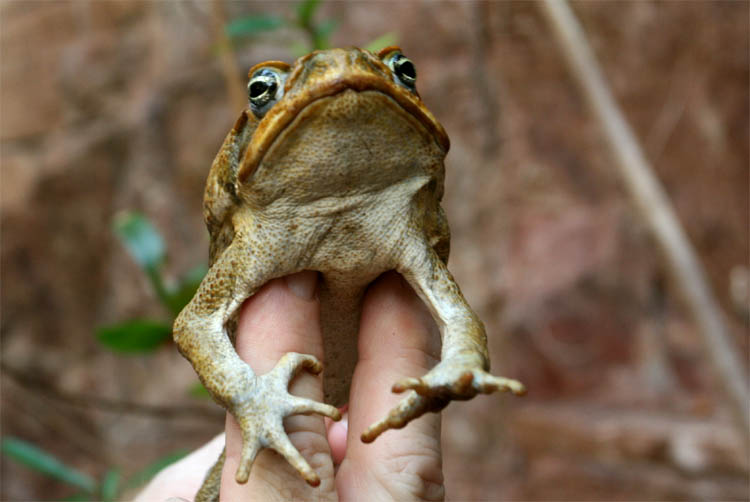
| Not being as anxious as a frog
|
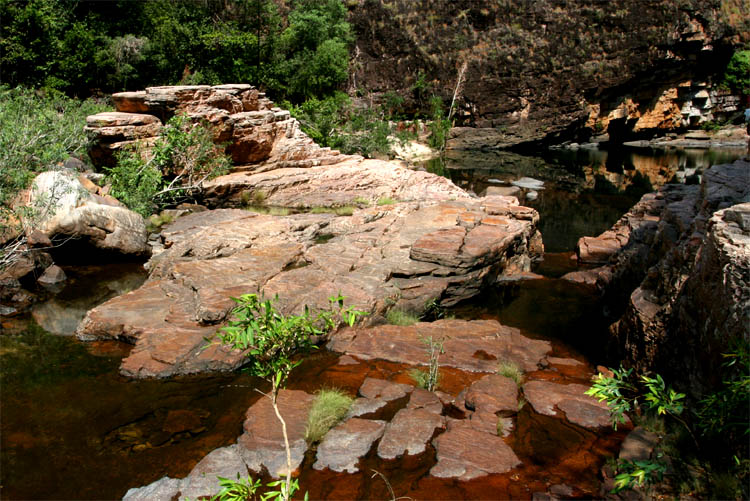
| On the way back over rocks
|
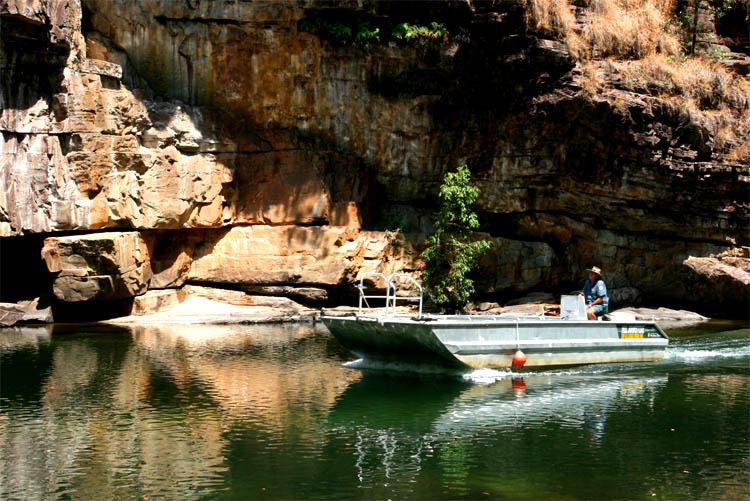
| to be picked up by our boat
|
After a short rest at the Twin Falls we went all the way back, with the same means of transport, to our parking lot, where we had our picnic lunch. Now our next endeavor. Going back 10km we took the right turn on another and not better track towards the Jim Jim Falls.
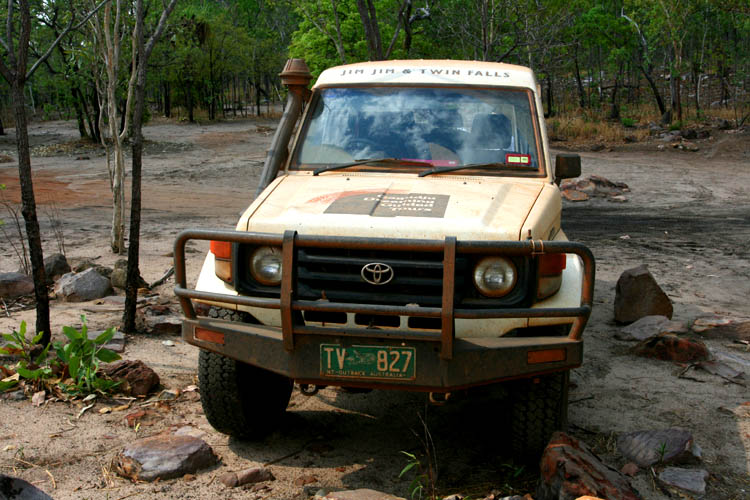
| Then getting back to our Landcruiser
|
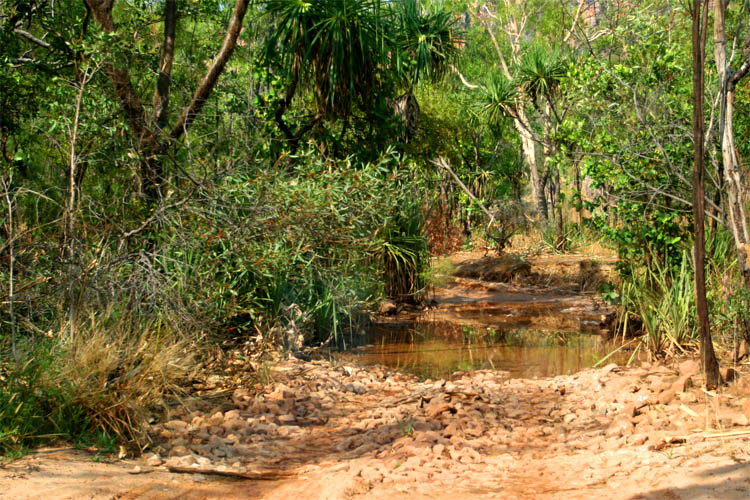
| making every dirt and puddle lake road
|
After another 10km we reached the Jim Jim Fall parking lot. Now the final and most strenuous part of our excursion started: a rugged 900m walk involving scrambling up and down rocks along the Jim Jim creek through the monsoon forest surrounded by towering 250m cliffs until we reached the Jim Jim Falls plunge pool.
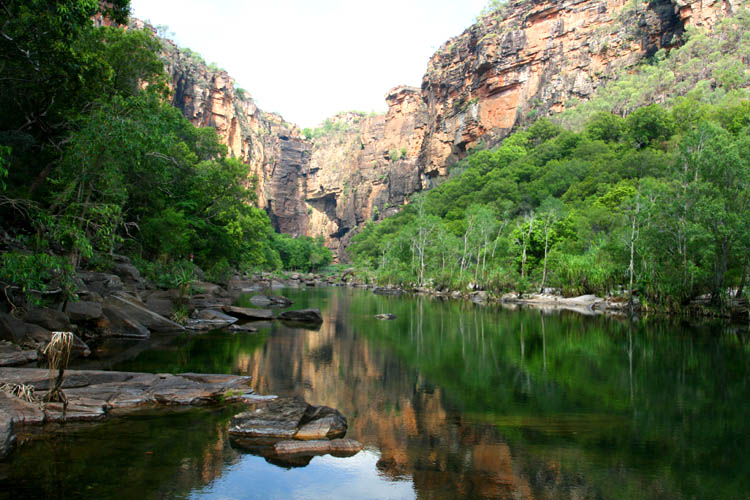
| The "trail" to walk along the Jim Jim creek
|
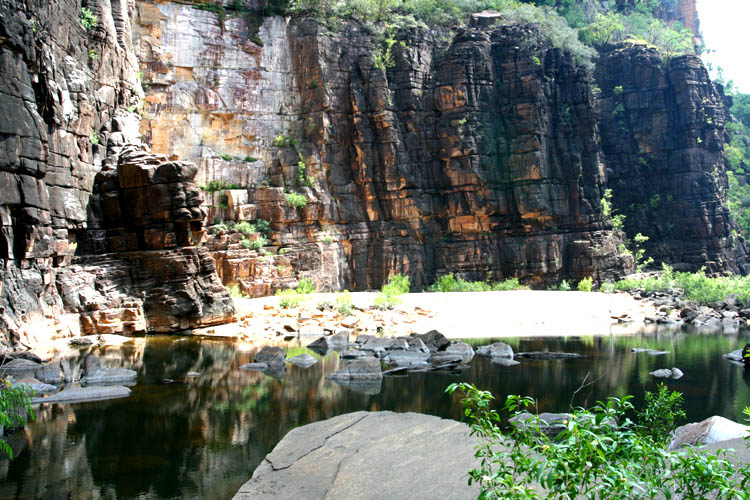
| with a beautiful sight along its bank
|
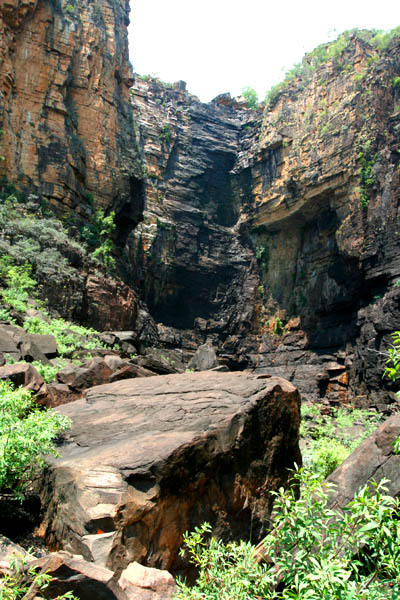
| Finally, the impressive cliffs
|
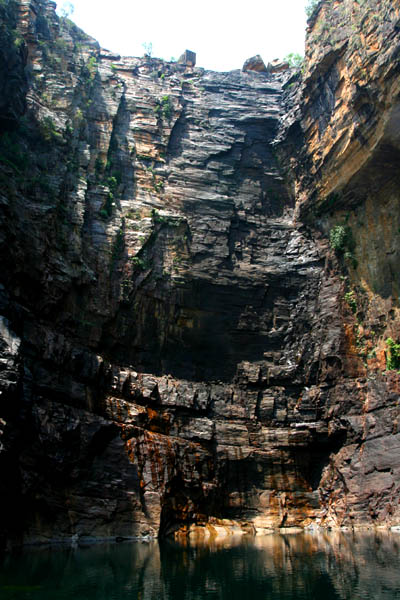
| of the fantastic Jim Jim Falls
|
What a place, and you can even swim here what we did. The lady from Adelaide just jumped into the glass clear water with all her clothes on (she almost fainted during the strenuous walk), eventually followed by her husband. The others and myself preferred to undress first.
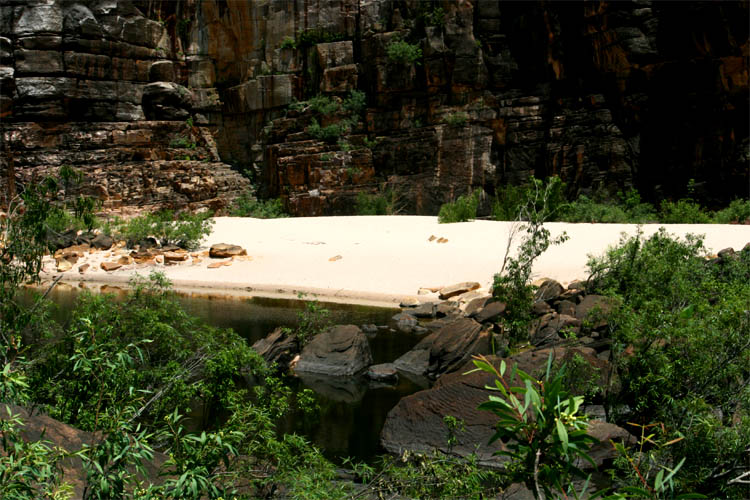
| No crocs are in sight
|
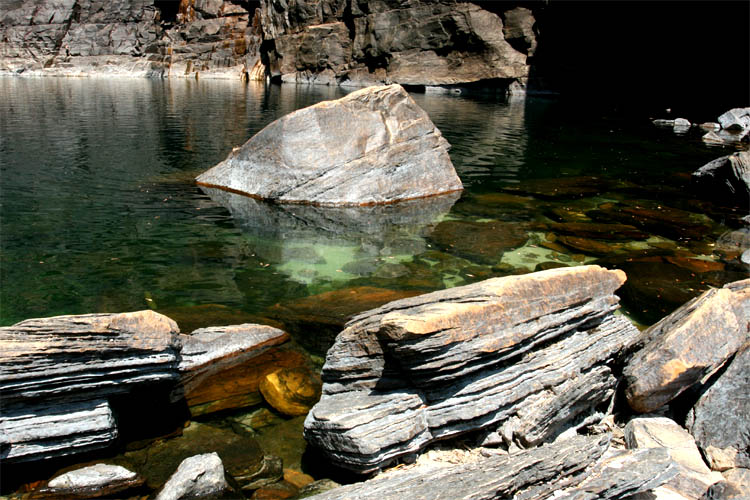
| not even in the lake
|
No crocs could come here except falling down the fall but then they probably will not have survived.
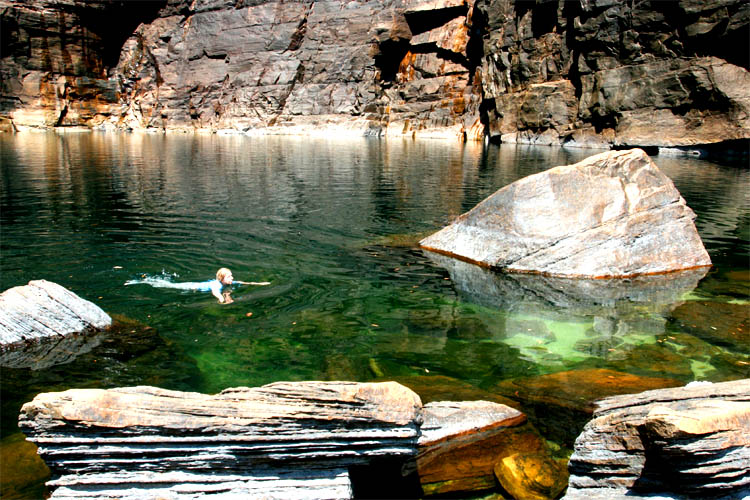
| So swimming is not dangerous
|
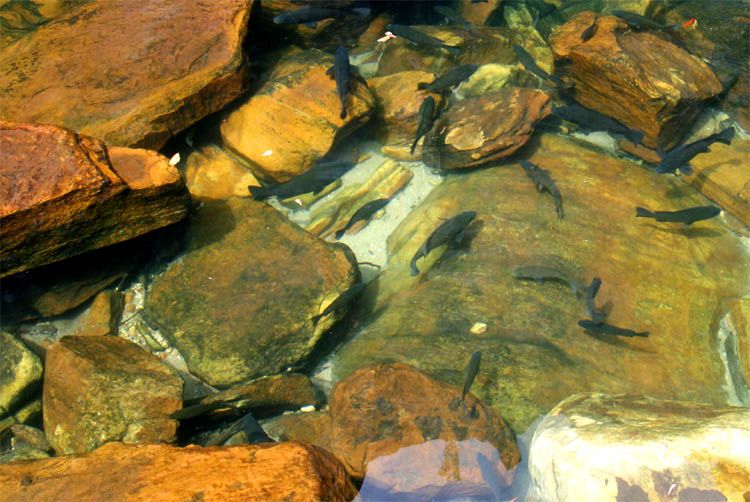
| and you can feel like a fish
|
Then on the way back we saw some Frilled Lizards. Very funny the way they walk on their hind legs. Also with their open frills, when they are angry (or aggressive). They were sitting on the road but then running away on a tree as soon as we tried to get close. Even after one has climbed the tree he is not easily spotted because as soon as you go around the tree he also moves trying to keep himself out of sight. Kevin said that he did not see so many on one day (and he is doing that tour for a couple of years almost daily during the dry season). What lucky guys we were.
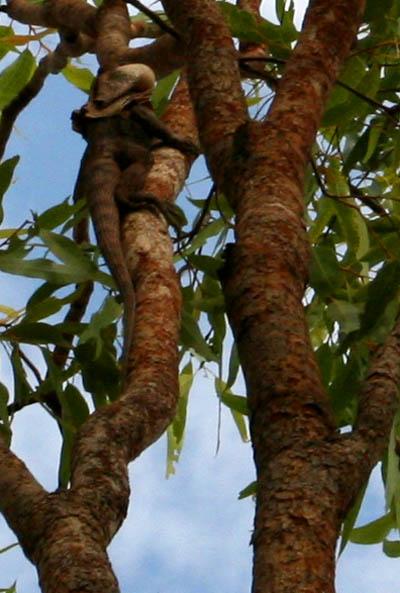
| What a surprise:
|
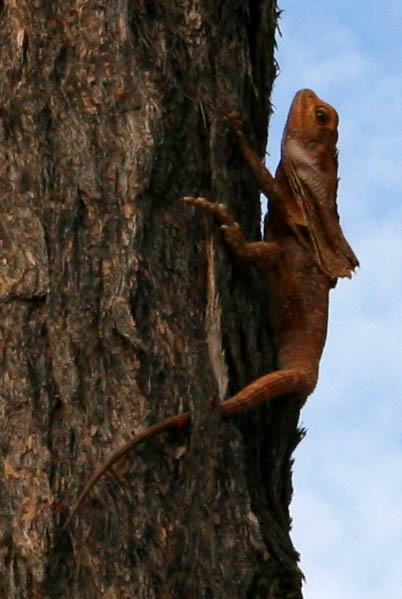
| a real Frilled Lizard
|
Back in my Kakadu Lodge I relaxed till sunset in and around the swimming pool and finished it off with a hearty meal.
That day was the best day in the Kakadu National Park and another highlight of my Australia trip.
Ubirr
Now the last day. With the AAT Kings Bus again and the same nice driver and guide lady, Lynne. First we were heading to Ubirr with a short walk to some nice rocks and a climb to the Nadab lookout with a 360 degree round view over the landscape.
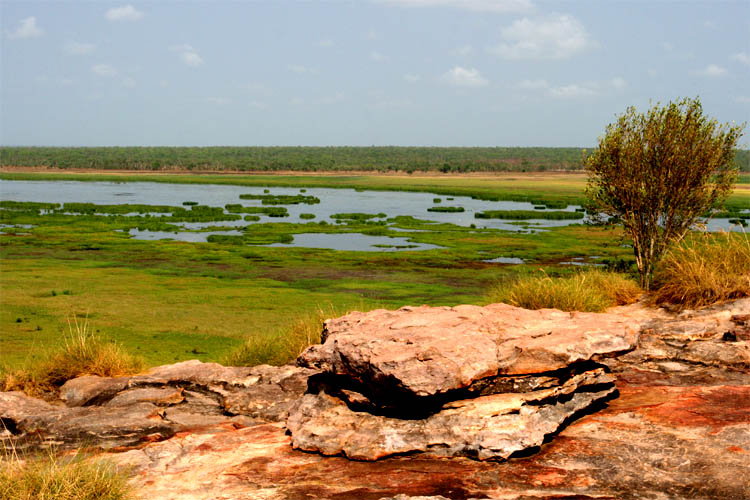
| Landscape around Ubirr
|
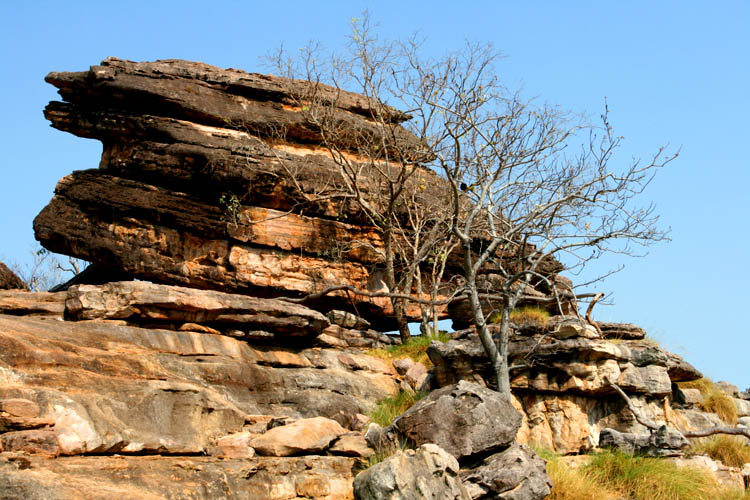
| with strange rock formation
|
People have lived here for 20,000 years, thus also some of the rock paintings are supposed to be that old, making them one of the oldest human works. The age cannot be exactly determined (like the carbon-14 dating method) but only with the help of certain pattern, the climate history and archaeology evidence.
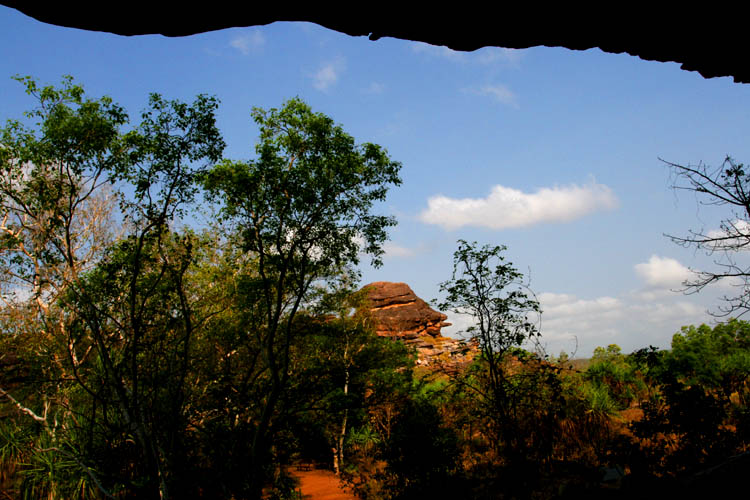
| A cave in the rock
|
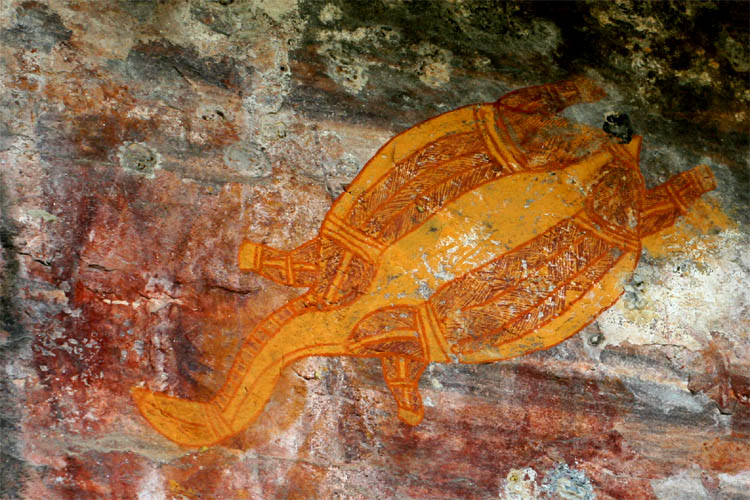
| reveals stunning rock paintings
|
Different styles of rock art are represented at Ubirr. From relatively simple red ochre paintings to some x-ray style painting, showing the internal structure of the animals, like fish, for example. A third style painting is contact art, i.e. the arrival of non Aboriginal people, for example: a white man with his hands in his pocket (supposed to be represented as a lazy people?). However, the rock art occurrence has diminished with the arrival of Europeans.
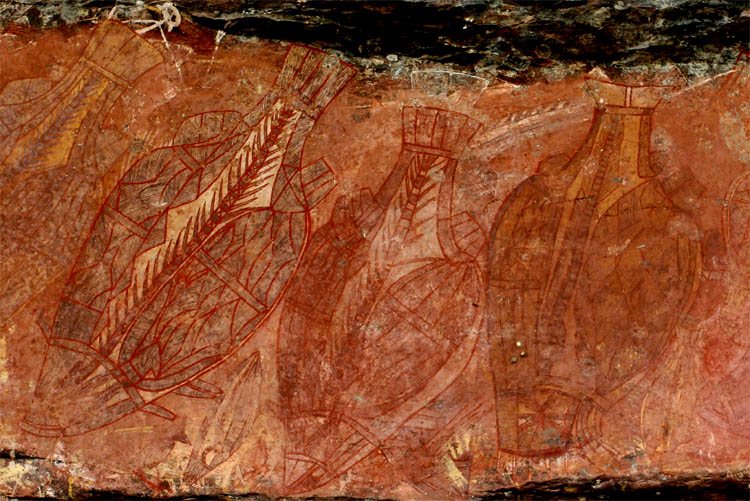
| X-ray style Barramundi fish
|
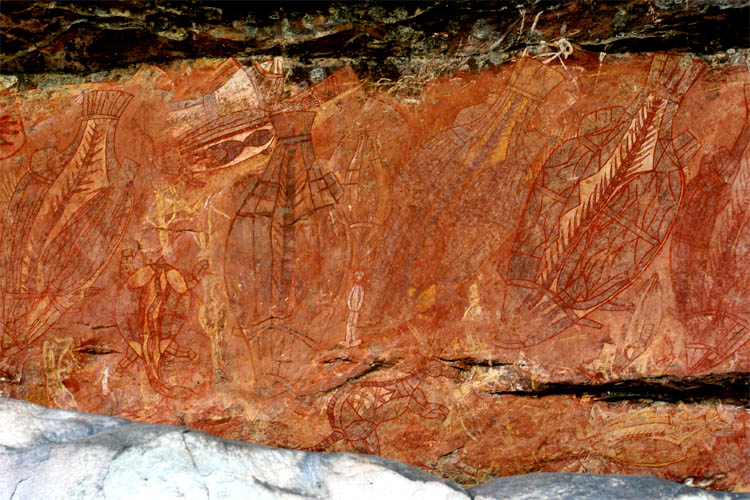
| all over. Just a small man in between
|
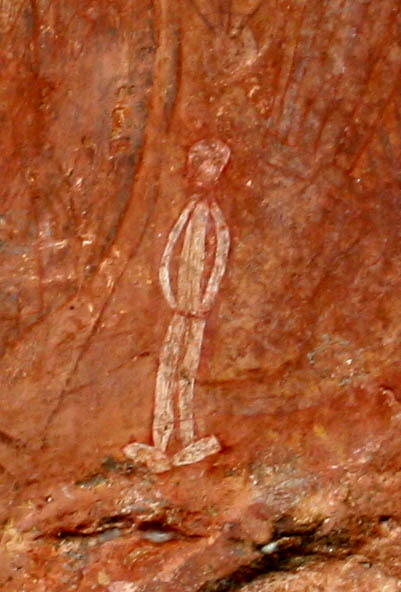
| representing one of the first white man they saw
|
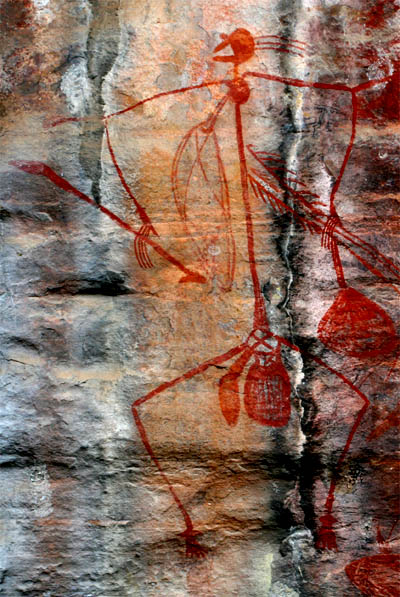
| and this is an Aborigine with hunting equipment
|
East Alligator River Cruise
The next stopover was at the East Alligator River. The name alligator is misleading. There are no alligators in Australia at all. The name was assigned by some early guy who did not know that. Now we embarked carefully on the boat to go on the Guluyambi Cruise to meet the dangerous saltwater and some "harmless" sweet water crocodiles.
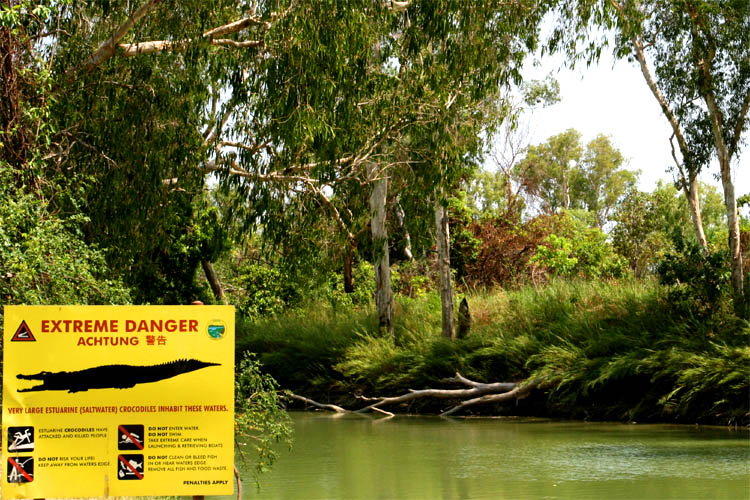
| At the Guluyambi river jetty
|
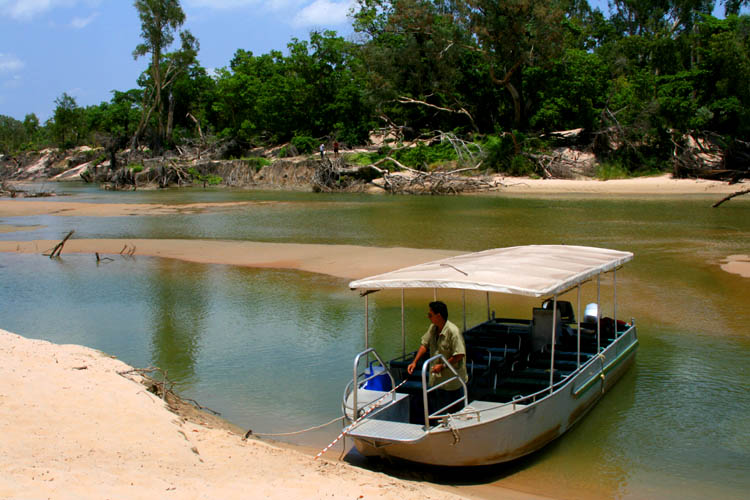
| going on a "dangerous" cruise
|
According to the tour's brochure:" we will be able to go ashore in Arnhem Land with special permission of the local people". Though there were no people to ask. The only (half) Aborigine was our boat man and guide.
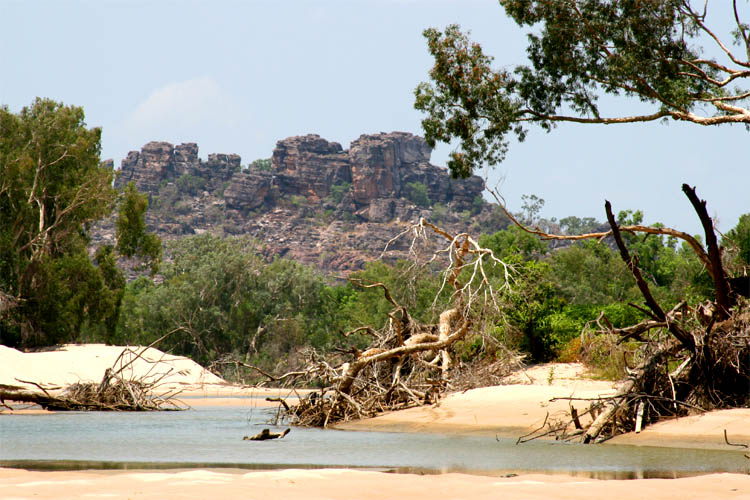
| Surrounded by impressive rocks
|
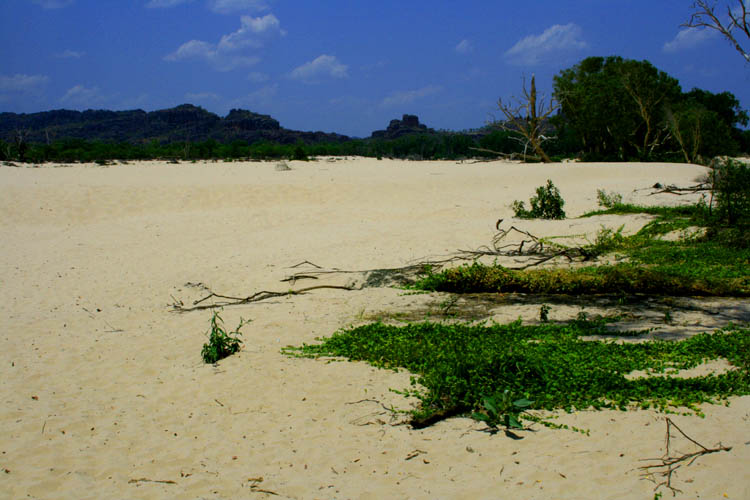
| and beautiful beaches only to look at
|
All the sand you see was not there last year. It all came down with a strong cyclone in March 2007, burying everything including most trees underneath.
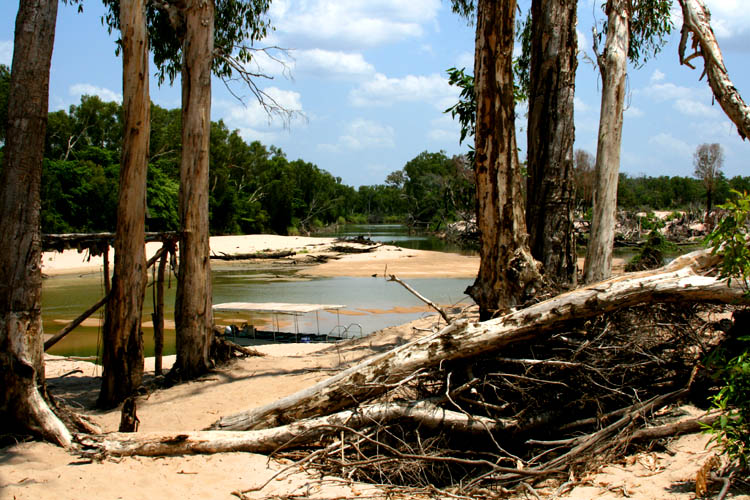
| Some trees survived the cyclone
|
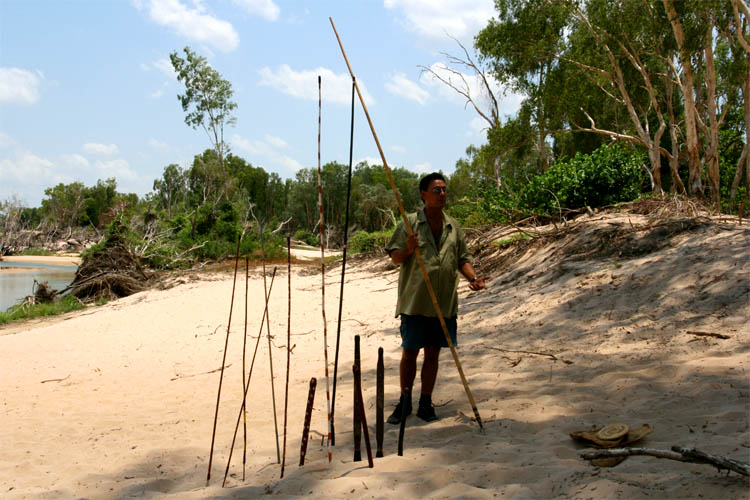
| Our guide tells about hunting methods
|
Our guide did not look like an Aborigine at all, though he was always talking in the "we" form when explaining Aboriginal life and customs and in a funny way. At the end of our cruise I asked him about his ancestors and was told that his mother was Aboriginal and his father was from the Czech Republic.
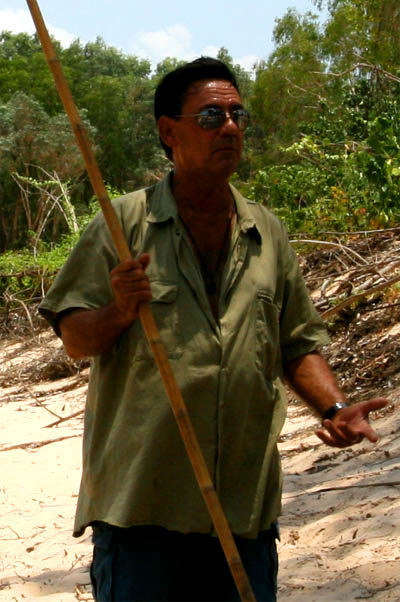
| How did the Aborigines used their spears?
|
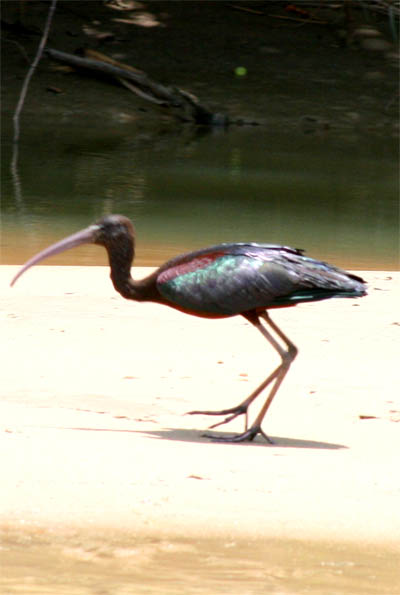
| Unfortunately also to hunt beautiful water birds
|
Then we saw a big croc crawling over the Cahill Crossing road flooded by only about 20cm now. That was the place where a couple of years ago a man was decapitated by a croc after he slipped while walking through the river on the road (I mentioned this earlier).
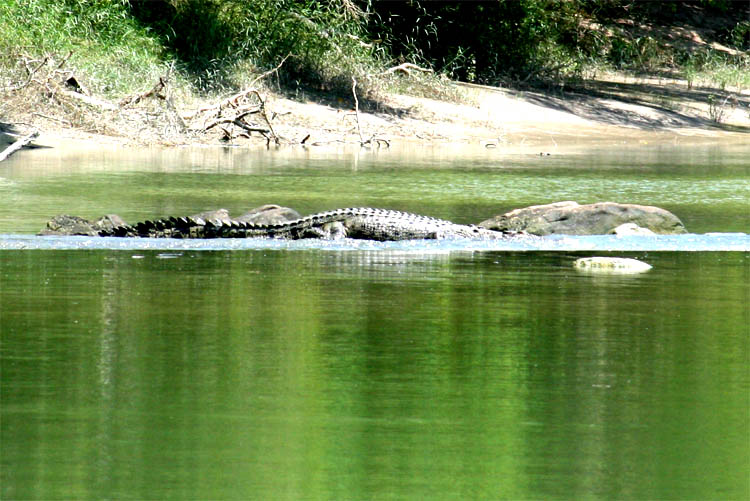
| Not necessarily spear hunting big crocs
|
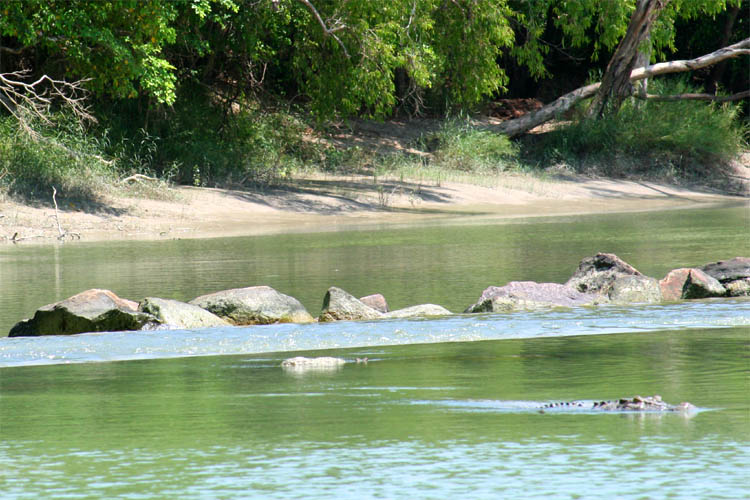
| while crawling over the Cahill Crossing road
|
Ranger Uranium Mine
After we survived the East Alligator River Cruise we continued to the Airport of Jabiru where we had our lunch, just a lunch box this time.
Then we went to the Ranger Uranium Mine. Uranium was found here in the year 1970, but production started 1981 and is supposed to close 2010 with the end of the lease from the Mirrar Aborigines.
There has been many discussions (and conflicts) between the government, mining company and the Aborigines to stop mining. Around $10 Mio. from the annual profit (of ???) are transferred to the Aboriginal owners, who seem to rely on it (what for?) and probably cannot easily give it up.
There were times before in the southern part of Kakadu, where people did get sick from all sorts of mining including uranium, so that the Aborigines called it "Sickness Country".
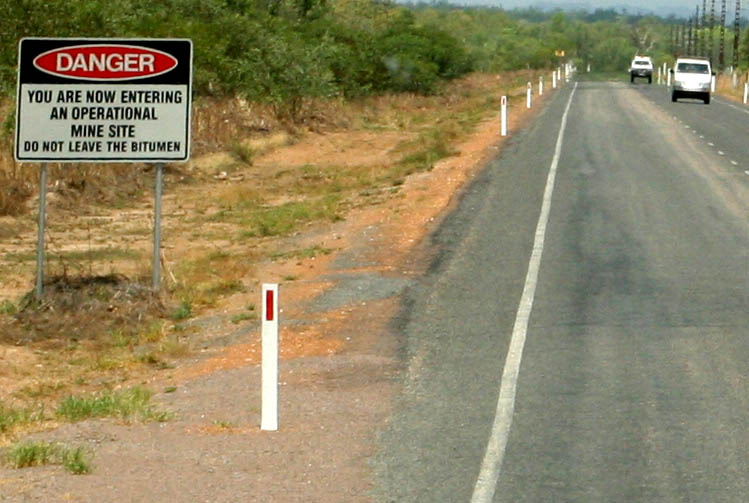
| More dangerous might have been uranium
|
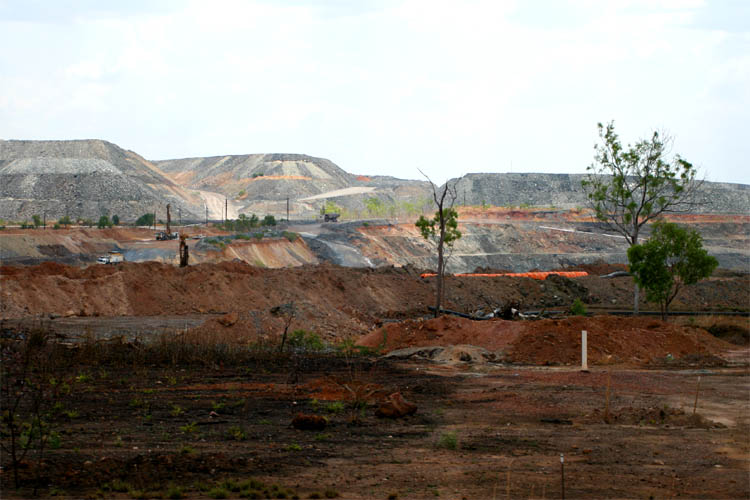
| being dug out with extensive mining
|
Bowali Center
After getting "contaminated" we went to the Bowali Center. It is actually the information center you should visit as a first stop to get all the information for your stay in Kakadu. The parking area was full with other tour operators.
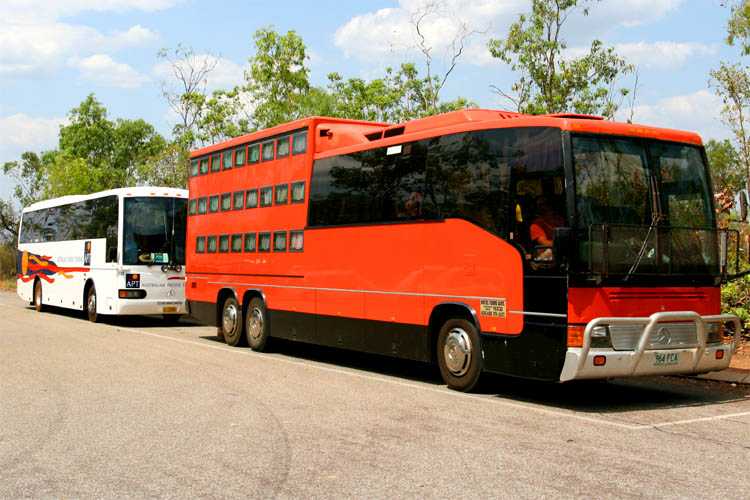
| Which is best? Rotel, APT
|
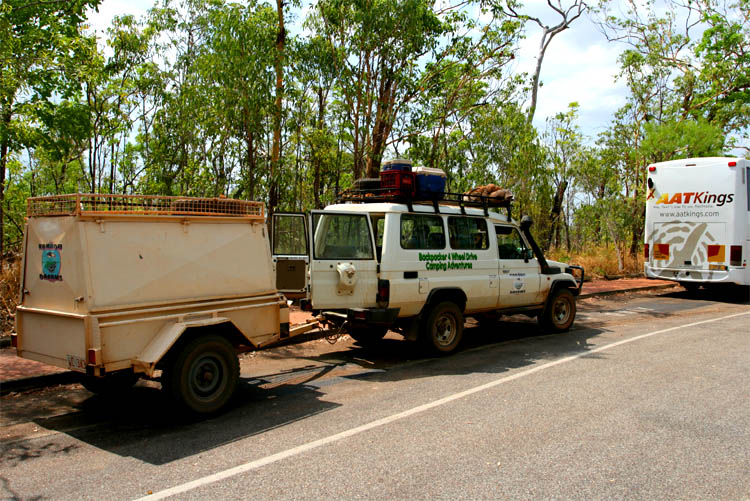
| Backpacker 4WD, or my AAT Kings?
|
Mamukala Wetlands
Then finally we had to hit the Arnhem Highway to go home, with one last sightseeing stop at the observation platform of Mamukala wetlands where thousands of birds (especially magpie geese) congregate during the end of the dry season, which was right now.
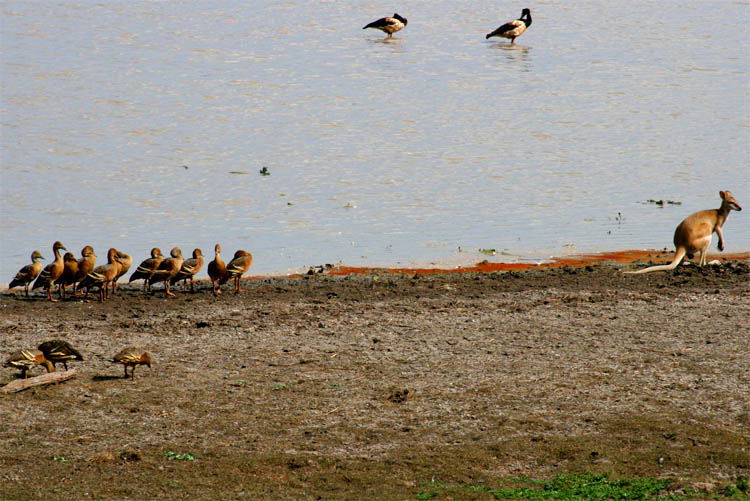
| Bird wild life and kangaroo
|
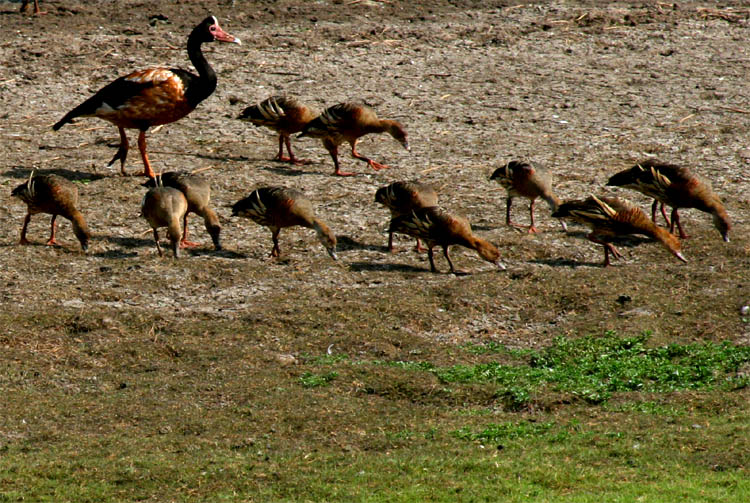
| in the Mamukala wetlands
|
Heading back to Darwin
After another brief stop at the Aurora Lodge, not for dinner though but I still studied their menu offering one of their "haute cuisine" meals with "maitre de butter".
During the 210km ride back to Darwin we were shown the movie "Crocodile Dundee", which was not only fun to watch but also it showed some places of the Kakadu we have visited.
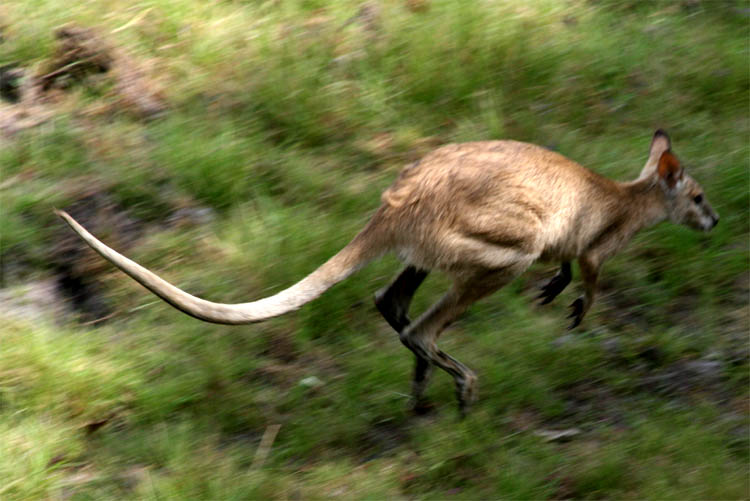
| Faster than a kangaroo can jump
|
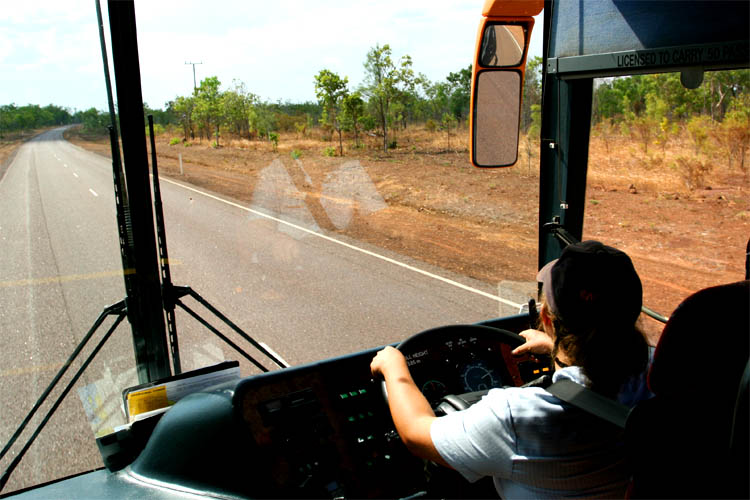
| we are finally heading back to Darwin
|
At 7:30 p.m. I was let out at my Cave again. I only can recommend AAT Kings
www.aatkings.com.
Ok, that was my fourth part of my trip to Australia. For any of the other parts click on
Part I or
Part II or
Part III.
As it was said before and will be said again: There could have been seen and done a lot more. Also I could have written more. If you want to know more all about the places I have visited, then just look up any of the many guidebooks or in the internet.
A word again to the Aborigines:
There is a certain tendency in my narrative as far as Aborigines are concerned that does not seem to be politically correct, but that was what I actually saw and experienced.
The real issue cannot be explained easily, though I will try it in a separate link
Aborigines.
| 














































































































